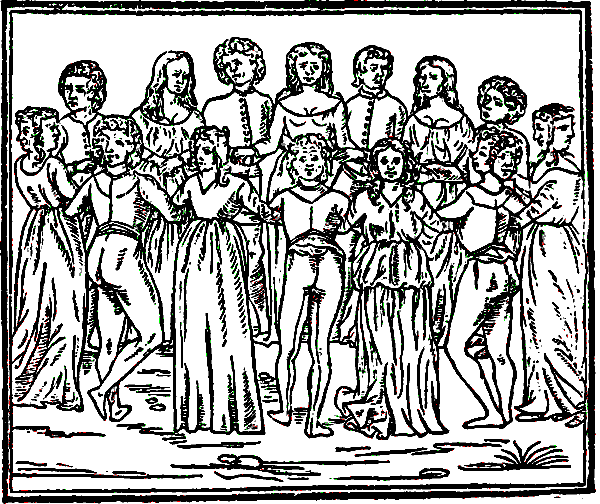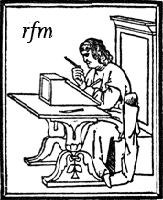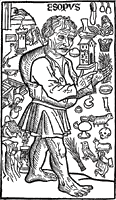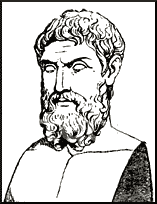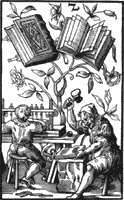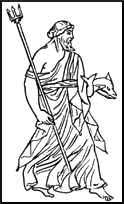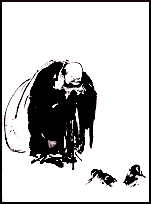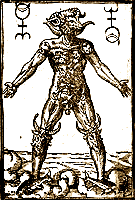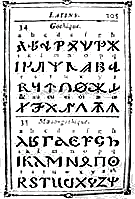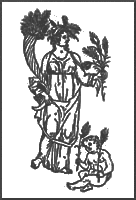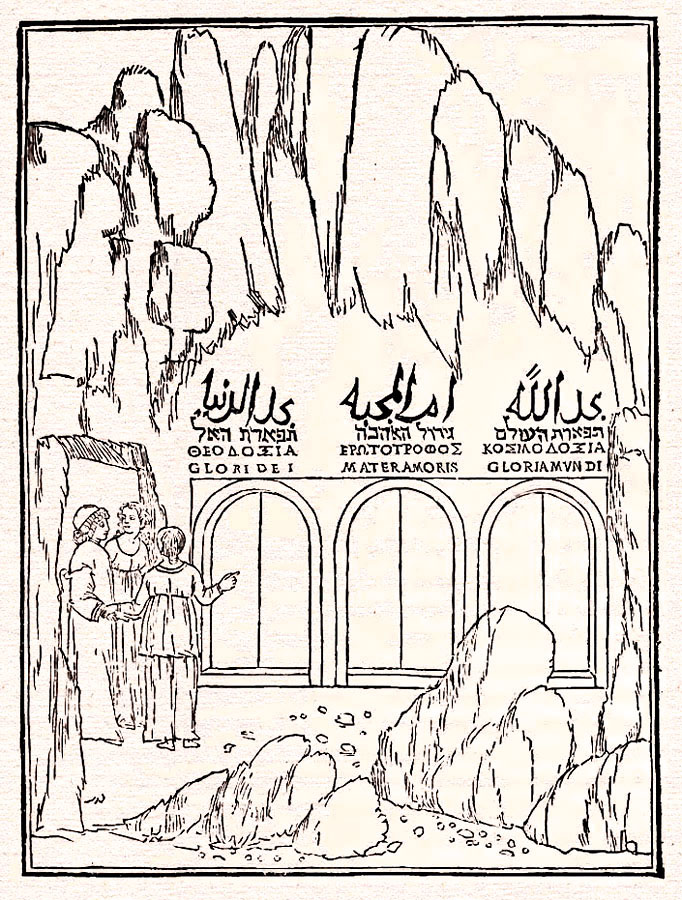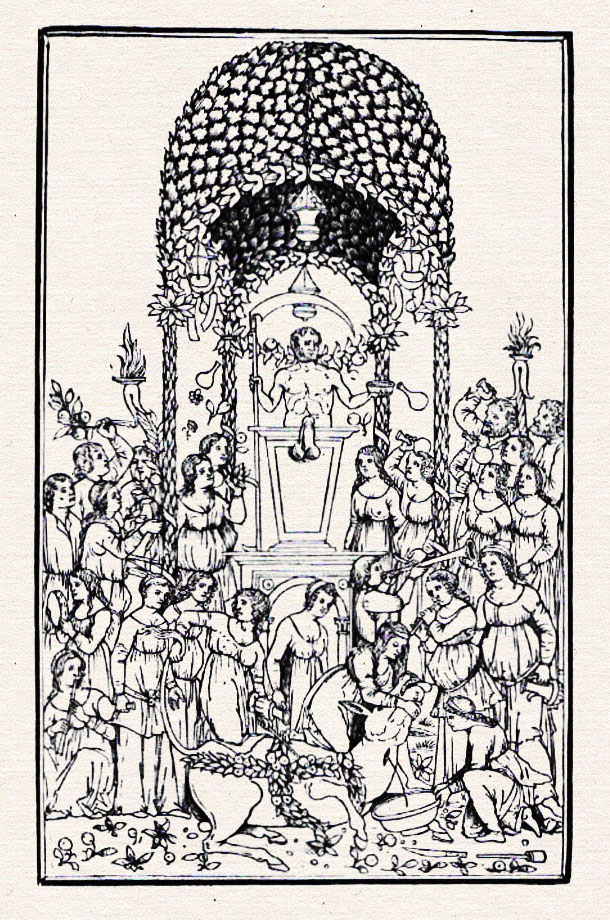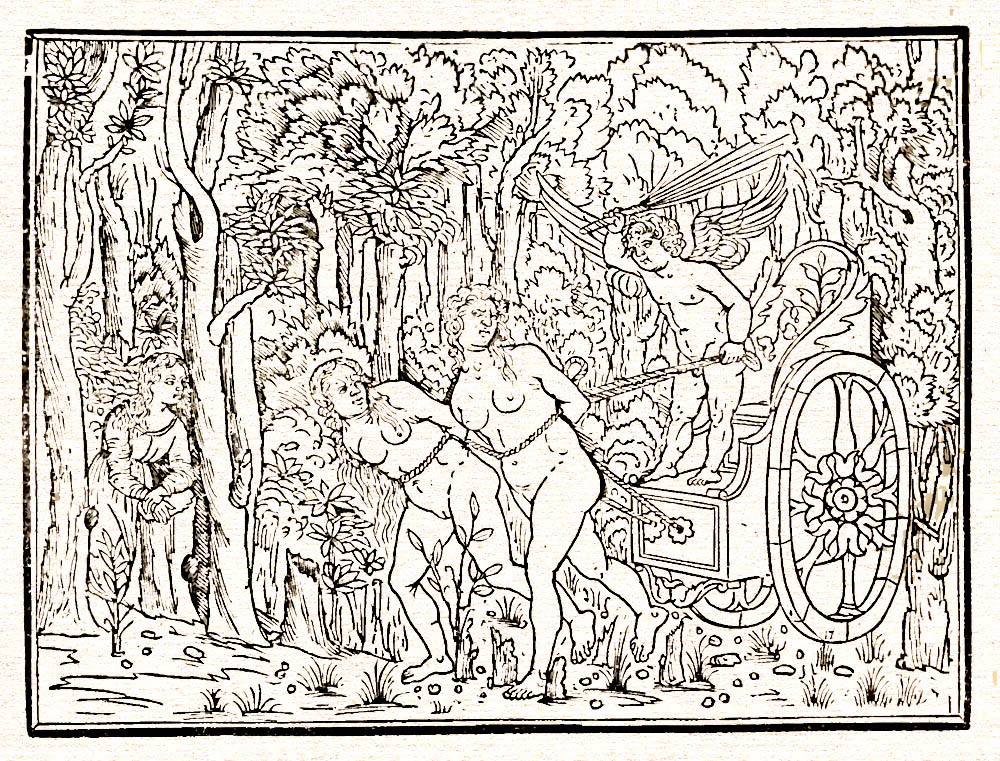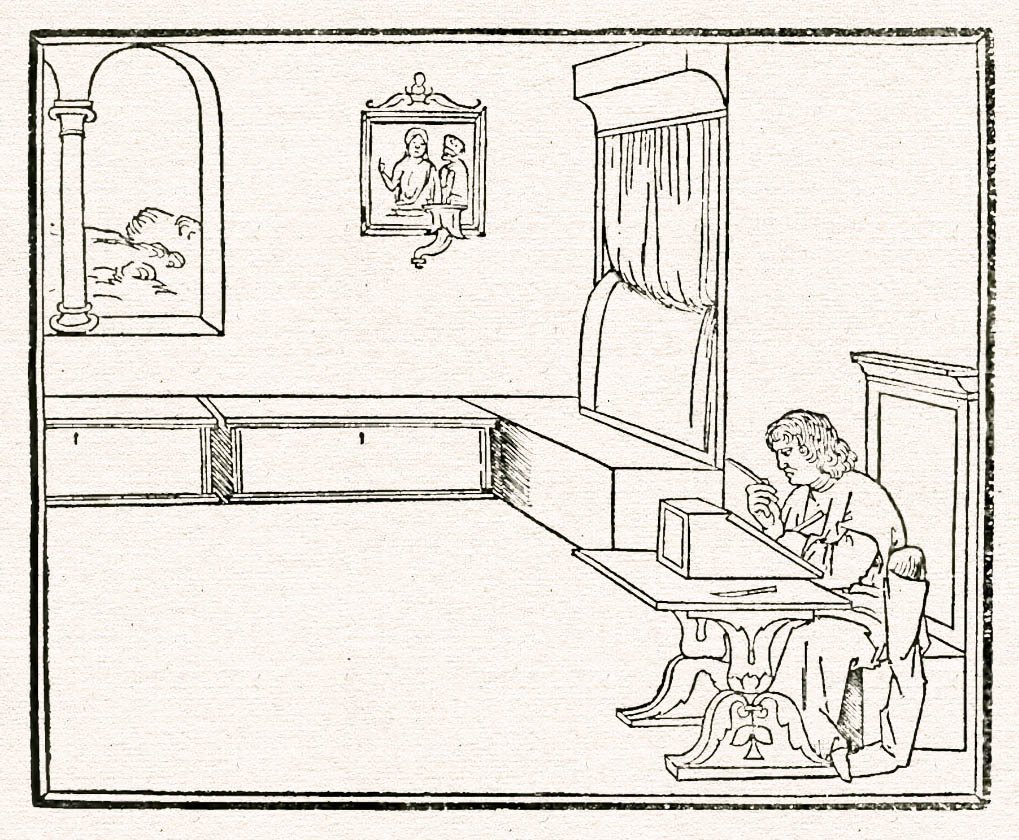Francesco Colonna: Hypnerotomachia Polifili
Hypnerotomachia Polifili
„Ut merito dici possit amor nodus perpetutis et copula mundi partiumque eius immobile substentaculum
ac firmum totius machine fundamentum.“
Francesco Colonna:
Hypnerotomachia Polifili. Edizione critica e commento a cura di Giovanni Pozzi e Lucia A. Ciapponi. [2 Bände:] Testo. Commento.
Verona: Stamperia Valdonega für Padua: Editrice Antenore, 1963.
Quarto. ca. 325 × 215 mm. Mit allen Illustrationen des Originaldruckes sowie Vergleichabbildungen in Band zwei.
Original-Leinwandbände mit goldgeprägten Rückentiteln, Kopfgoldschnitt, vorn und unten unbeschnitten.
Druck der Stamperia Valdonega nach den Anweisungen Hans Mardersteigs auf Carta ventura de Cernobbio; Band 1 in Polifilo, Band zwei in Bembo gesetzt. Es wurden insgesamt nur 1300 Exemplare hergestellt, davon waren 600 nicht für den Handel bestimmt, wovon dies Nr. 270.
¶ Ein Neusatz, kein Faksimile, von unvergleichlicher Schönheit in Proportion und Gestaltung, und zugleich eine textkritische Ausgabe mit ausführlichem Kommentar in Band 2 sowie allen Holzschnittabbildungen der Erstausgabe des Inkunabeldruckes bei Aldus in Band 1.
¶ Einer meiner Professoren an der Freien Universität Berlin, Gerhard Goebel, Übersetzer von Pierre Klossowski, Le Baphomet, hatte diese kritische Ausgabe gelesen, sonst wohl einer der in der Gegenwart am wenigsten beachteten Romane europäischer Literatur; ich selbst habe mich mit Joscelyn Godwins englischer, wohlillustrierter Übersetzung zufriedengegeben.
Erste kritische Ausgabe.
Stamperia Valdonega
¶ Die wurde 1948 von Giovanni Mardersteig gegründet. Sie nahm ihre Geschäftstätigkeit basierend auf den Erfahrungen der 1922 in Lugano entstandenen Officina Bodoni im Stadtteil Valdonega von Verona auf. Zuvor hatte Mardersteig Aufträge, die er gestaltete, bei Mondadori in Verona drucken lassen. In der neuen Firma installierte er zusammen mit seinem technischen Leiter Walter Leonhardt aus Leipzig eine Handsetzerei, sowie eine Monotype-Setz- und Buchdruckmaschine, später folgten zwei Einfarben-Offsetmaschinen. 1952 wurde das Werk erweitert und Verträge mit großen Verlagen abgeschlossen: Riccardo Ricciardi, Editrice Antenore, Adelphi, Sansoni, im Ausland Collins Publishers, Folio Society, Tauchnitz Edition, Hoffmann & Campe, Hanser Verlag, Propylän Verlag, Limited Editions Club und New Directions. Sein Sohn Martino trat 1968 in die Stamperia ein und übernahm 1977 nach dem Tod seines Vaters sowohl diese wie auch die Officina Bodoni. Bis 1990 befanden sich drei Monotype-Setz- und drei Johannisberger Buchdruckmaschinen regelmäßig im Einsatz. 1984 widmete das New Yorker Metropolitan Museum der Firma eine bedeutende Ausstellung: The Mardersteig’s Work in the Stamperia Valdonega; 1991 organisiert der Grolier Club eine weitere. 1995 bis 1996 wurde das Unternehmen nach Arbizzano in einem größeren und funktionaleren Betrieb verlegt. Auf der einen Seite kam dort der spezialisierte Textsatz insbesondere durch die digitalisierten Typen der Valdonega Aesthetic Line (VAL) zur Geltung, dies umfaßte die Schrifttypen Dante, Baskerville, Bembo, Bodoni, Centaur, Garamond, Garamond Simoncini, Gill Sans, Impressum, Janson, Times, Van Dijck und Greco; auf der anderen konzentrierte man sich nicht nur darauf, Faksimiles und Kunstbücher in kleinen, sondern auch Kataloge in größeren Auflagen herzustellen. Anfang 2007 wurde die Stamperia Valdonega von der SIZ-Gruppe übernommen, um deren Angebot auf dem Markt für hochwertigen Buchdruck zu stärken. Seit Anfang 2008 stehen sowohl die Buchdruckpressen der Stamperia wie die Handpressen der Officina still.
Editio princeps
Renouard
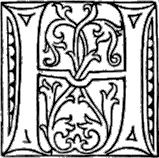 ypnerotomachia Poliphili, ubi hvmana omnia non nisi somnivm esse docet. atqve obiter plvrima scitv sane qvam digna commemorat. Cavtvm est, ne qwis in Dominio Ill. S. V. impvne hvnc librvm qveat impprimere. – Venetiis Mense decembri. M. ID. in aedibus Aldi Manutii, accuratissime. In-fol. Fig. en bois.
ypnerotomachia Poliphili, ubi hvmana omnia non nisi somnivm esse docet. atqve obiter plvrima scitv sane qvam digna commemorat. Cavtvm est, ne qwis in Dominio Ill. S. V. impvne hvnc librvm qveat impprimere. – Venetiis Mense decembri. M. ID. in aedibus Aldi Manutii, accuratissime. In-fol. Fig. en bois.
Ce livre bizarre, écrit dans un langage italien mélé de mots estropiés du grec, de l’hébreu, &c. &c., qui en rendent la lecture pénible, et souvent rebutante, n’est cependant pas sans mérite, surtout si l’on considere le temps où il a été écrit. C’est une suite de descriptions pittoresques, d’idées architecturales, souvent neuves et ingénieuses, qui décèlent une assez grande connoissance des beaux arts, et surtout un amour ardent pour les chefs-d’oeuvre de l’antiquité, au goût desquels l’auteur vouloit ramener son siecle, encore trop attaché au gothique. C’est une source à laquelle plus d’un artiste, plus d’un littérateur, sont venus puiser sans en faire confidence au public, et où d’autres pourront puiser encore, et peut-être dans un semblable incognito.
Les nombreuses gravures en bois qui décorent ce livre, sont aussi singulières que l’ouvrage mème; et, parmi beaucoup de sujets bizarres, elles en présentent quelquesuns du meilleur goût, et d’une très riche ordonnance. Dans ma première édition, j’ai dit qu’elles paroissoient ètre faites d’après les dessins d’Andrea Mantegna : des Italiens bons connoisseurs en peinture, et surtout bien en état de discerner la manière des divers peintres de l’Italie, sont d’avis qu’on doit les attribuer à Giovanni Bellino, peintre vénitien, dont le nom est peut-être indiqué par la lettre .b. qui se voit dans la gravure du sixième feuillet du cahier a, première partie. Quant à l’opinion de ceux qui attribuent ces dessins à Raphael, elle est d’autant plus mal fondée que cet artiste, né en 1483, étoit encore trop jeune pour les avoir exécutés.
Il y a eu de la traduction françoise quatre éditions, de 1546, 1554, 1561, in-fol., et 1600, in-4°, avec des gravures en bois, copiées sur celles de l’italien, mais d’après des dessins plus corrects, que l’on croit de J. Goujon, habile statuaire, ou de J. Cousin, peintre célèbre. Malgré cet avantage, les exemplaires françois sont recherchés de peu de personnes, tandis que les deux éditions italiennes, et surtout celle-ci, de 1499, sont des livres rares et d’un haut prix.
On trouve un extrait de ce livre dans le volume Gg, 31e des Mélanges tirés d’une grande bibliothèque. Mirabeau en a formé un conte assez agréable, par un très court extrait placé à la suite de sa traduction de Tibulle, t. 3.
J. G. Legrand, architecte, en a donné une traduction ou plutòt une imitation abrégée, en 2 vol. in-18, Paris, Didot l’ainé, 1804, réimprimée en 1811, par Bodoni, 2 vol. in-4°.
Indépendamment de cette esquisse de traduction, Legrand se proposoit de donner l’ouvrage complet, dont il auroit fait une édition in-4° ou in-fol. du plus grand luxe, avec le texte en regard, et des gravures qui, je crois, ont été commencées à Rome; mais sa mort, arrivée vers 1806, empècha l’exécution de ce projet; elle l’empècha aussi de me rendre l’exemplaire italien d’édition Aldine que je lui avois prété pour son travail, et que ses héritiers ne voulurent pas me restituer, disant que comme ils avoient renoncé à sa succession, je devois aussi renoncer à l’espoir de recouvrer mon volume.
L’auteur, Franciscus Columna, ne s’est point nommé, mais il a indidué son nom d’une manière qui répond à la singularité de l’ouvrage. En rassemblant les premières lettres de chacun des 38 chapitres de ce livre, on trouve le nom de l’auteur dans la devise suivante, formée par ces 38 lettres:
Poliam frater Franciscus Columna peramavit.
Il étoit dominicain à Venise, où il mourut, en juillet 1525, agé de plus de 80 ans. Il paroit qu’il se fit moine peu après 1467, et que ce fut de douleur de la mort ou de l’éloignement de sa maitresse.
On prétend que quelques gens de mauvaise foi ont cherché à faire passer ce livre pour avoir été imprimé à Trévise, 1467, en arrachant le feuillet d’errata, au bas duquel est la souscription avec la date; de manière qu’alors le volume finit par la page précédente, où est ainsi indiquée la date de la composition de cet ouvrage:
Taruisi cum decorissimis Poliæ amore lorulis, distineretur misellus Poliphilus.
M. cccc. LxvII. Kalendis Maii.
Quoi qu’il en soit de la vérité de cette anecdote, il est bon de vérifier avec soin les exemplaires que l’on rencontre de ce rare volume. Au commencement sont 4 feuillets contenant le titre, une épitre de Leonardo Crasso, et autres préliminaires. Le corps de l’ouvrage commence par un titre séparé. La premiere partie est signaturee a jusqu’à z, ce dernier calmierz ayant dix feuillets. La seconde partie A jusqu’a F. C’est sur le troisième feuillet de cette dernière signature, que se trouve la date de Trévise, 1467, et sur le quatrieme, celle de 1499, au bas d’un long errata. Le volume contient en tout 234 feuillets non chiffrés.
La figure, représentant un sacrifice à Priape, au sixième feuillet du cahier m, étant un peu libre, se trouve quelquefois grattée ou tachée d’encre. C’est à quoi il faut faire attention.
M. le comte Méjan avoit un exemplaire sur vélin de la première partie qu’il eut la satisfaction de completer par l’acquisition de la seconde, aussi sur vélin, que lui cèderent MM. Remondini de Bassano, mais avec le feuillet de souscription réimprimé, ou copiè à la main ainsi que dans les deux suivants, dont l’un fut payé 27 l. 6 sh. chez Pinelli, n° 3270, et l’autre 82 l. 19 sh. chez M. Hibbert qui l’avoit acheté 90 l. Il avoit été vendu 900 fr. chez Mac-Carthy, 315 fr. chez La Vallière, et 310 l. 4 sols chez Gaignat. M. le duc de Devonshire, le mieux partagé des quatre possesseurs de cette rareté typographique, a l’exemplaire bien complet de Grolier, dont l’exemplaire sur papier appartient à lord Spencer.
Plusieurs bibliographes ont cru ce volume imprimé ailleurs que chez Alde, et avec d’autres caractères que les siens, à la réserve de la dernière page portant l’errata. Mais la confrontation de ce livre avec d’autres éditions Aldines du mème temps, m’a complétement prouvé que les differences présumées n’existent point, et que les caractères, tant latins que grecs, sont absolument les mèmes qui ont imprimé d’autres in-folio d’Alde, et notamment le Politien, de 1498. D’ailleurs la réimpression Aldine de l’Hypnerotomachia, de 1545, est encore faite avec les mèmes caractères.
— Antoine Auguste Renouard: Annales de l’imprimerie des Alde, histoire des trois Manuce et de leurs éditions. Troisième édition. Paris: Jules Renouard, 1834. pp. 21-22.
Didot
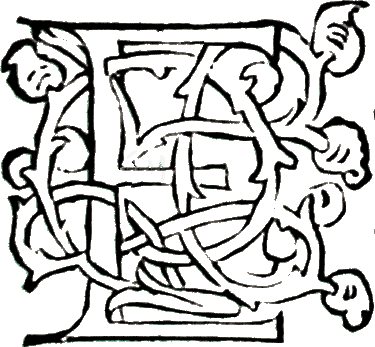 n décembre 1499, parut un autre ouvrage, d’une grande importance sous le rapport de l’art du dessin et de la typographie : c’est l’Hypnerotomachia Poliphili, roman allégorique, écrit en italien macaronique, où l’auteur, François Colonna, frère dominicain, a mystérieusement déguisé son nom et le but de l’ouvrage qui est son amour pour Polia (Hippolita), qu’on croit être une religieuse. Pour reconnaître leurs deux noms, il suffit de réunir la première des lettres de chacun des trente-huit chapitres de l’ouvrage, dont l’ensemble forme ces mots :
n décembre 1499, parut un autre ouvrage, d’une grande importance sous le rapport de l’art du dessin et de la typographie : c’est l’Hypnerotomachia Poliphili, roman allégorique, écrit en italien macaronique, où l’auteur, François Colonna, frère dominicain, a mystérieusement déguisé son nom et le but de l’ouvrage qui est son amour pour Polia (Hippolita), qu’on croit être une religieuse. Pour reconnaître leurs deux noms, il suffit de réunir la première des lettres de chacun des trente-huit chapitres de l’ouvrage, dont l’ensemble forme ces mots :
POLIAM FRATER FRANCISCUS COLUMNA PERAMAVIT.
1er chap. : P hobo in quel hora manando, etc.
2e chap. : O ffuscare già principiato avendo, etc.
3e chap. : L a spaventevole Sylva, etc.
4e chap. : I ustissimamente se potrebbe, etc., etc.
5e chap. : A lla nobile turba, etc.
6e chap. : M agna e nobile causa, etc.
et ainsi de suite pour les autres trente-deux chapitres.
Cette énigme est dévoilée dans le manuscrit de la bibliothèque des Dominicains, où on lit : « Nomen verum est Franciscus Columna, Venetus, qui fuit ordinis prædicatorum, et dum amore ardentissimo cujusdam Hippolyte teneretur Tarvisü, mutato nomine, Poliam eam autumat, cui opus dedicat ut patet. Librorum capita hoc ostendunt, ut pro unoquoque libro prima litera ita simul juncta dicunt. »
La crainte des censures de l’Église avait fait ainsi déguiser leurs noms dans cet ouvrage, où les effets d’une passion plus ou moins platonique sont décrits avec un sentiment plein de charme, témoin le passage cité par M. Baschet, quand Polia, fière de sa noble et antique origine, raconte comment, sans qu’elle y songeât, Polyphile, son bien-aimé, s’était épris pour elle d’une invincible passion. « Je me tenais, selon la coutume des belles adolescentes, à la fenêtre ou plutôt au balcon de mon palais. Mes cheveux blonds, délices des jeunes filles, flottaient épars sur mes candides épaules. Tout baignés d’une ambroisie à les rendre aussi rayonnants des fils d’or, ils séchaient aux rayons de l’ardent Phébus. Glorieusedeme servir, une femme y passait un peigne avec des soins infinis. Non, je l’ose dire, ni ceux d’Andromède n’apparurent aussi beaux à Persée, ni ceux de Photis à Lucius. Tout à coup Polyphile, m’ayant aperçue, ne put détacher de moi ses ardents et dévorants regards, et de ce moment un rayon du soleil de l’amour s’alluma dans son sein. »
Dans ce roman philosophique, sorte de poëme en prose, composé en 1467, et probablement à l’imitation des amours poétiques de Pétrarque et de Dante, l’amant voit en songe sa maîtresse comme dans le Roman de la Rose ; mais, en faisant le récit d’un voyage à Cythère, l’auteur se plaît à décrire les fêtes, les monuments et les usages de l’antiquité ; il n’est pas jusqu’aux tombeaux dont il n’explique les épitaphes pour faire montre de savoir. Les nombreuses gravures au trait, d’un très-beau dessin et exécutées sur bois avec beaucoup d’art, ont été d’abord attribuées à Mantegna, puis à Bellini; on voit en effet un b à la gravure du dixième feuillet (verso), initiale qui pourrait aussi indiquer Benedetto Montagna. Ce monument, l’un des plus anciens, et sans contredit le plus remarquable de la gravure italienne sur bois, fut exécuté aux frais de Leonardo Crasso de Vérone. Le sujet de ces mêmes compositions a servi pour une imitation qui en fut faite à Paris, aussi sur bois, dans les trois éditions de la traduction de ce roman imprimées par Jacques Kerver en 1546, en 1554 et en 1561. L’exécution en est très-belle, et le dessin des gravures, quoique d’un style très-différent de l’original, qui est souvent modifié, offre un tel mérite que je crois devoir les attribuer à Jean Cousin . Le frontispice est en effet entièrement dans son style.
En 1753, Luther Garet, dans ses dissertations sur le traité d’Unger, de Aldi Pi Manutii vita, etc., et en 1759, M. Manni, dans sa Vita di Aldo Pio Manuzio, ont élevé des doutes au sujet de la belle publication de l’Hypnerotomachia, que le Père Orlandi, d’après l’opinion émise avant lui, supposerait avoir été imprimée à Trévise.
Voici les raisons qu’ils donnent à l’appui :
1° L’ouvrage se termine ainsi : Tarvisii cum decorissimis Polii amore lorulis distineretur misellus Poliphilus. MCCCCLXVII Kalendas Martii.
2° Le nom d’Alde et la date 1499 ne se trouvent que sur la seule page du dernier feuillet contenant l’errata ; il commence ainsi : Li errori del libro, facti stampando, li quali corrige cosi, et au bas de cette page, on lit : Venetiis, mense decembri M.I.D. in ædibus Aldi Manutii accuratissime.
3º L’impression de cette dernière page est faite en un caractère que l’on ne rencontre dans aucune des autres impressions d’Alde.
4° Le papier n’est pas le même.
5° Alde, qui se plaît à décorer ses ouvrages de préfaces, pièces de vers et autres renseignements, s’en est abstenu dans ce chef-d’oeuvre.
6° Dans la préface écrite par Leonardo Crasso de Vérone, il n’est pas dit que ce livre soit imprimé par Alde; mais au contraire qu’il est publié par les soins et aux frais de Leonardo Crasso.
Ces observations ne sont pas sans valeur et m’ont conduit à un examen attentif.
La question des caractères, la plus importante de toutes, est précisément celle qui résout le problème, puisqu’il résulte de mon examen que l’ouvrage est imprimé avec les caractères d’Alde aussi bien latins que grecs, sauf la page de l’errata à la fin du volume, dont le caractère (dit cicéro) ne me paraît pas, non plus qu’à Renouard, se rencontrer dans d’autres livres imprimés par Alde; mais, du moment qu’Alde lui-même a inscrit son nom au bas de ces Errata, cela prouve qu’il en est l’imprimeur. Toutefois Renouard a commis une erreur en ce qui concerne la similitude du caractère employé dans l’Hypnerotomachia avec celui des auvres de Politien, imprimées par Alde en 1498. Les beaux caractères de l’Hypnerotomachia sont les mêmes que ceux qui ont servi à l’Ætna de Bembo et aux Diaria de Bello Carolino (1495-1496), tous deux pour le bas de casse seulement, et dans le livre de Pic de la Mirandole, de Imaginatione (1501), pour le bas de casse et les capitales.
Quant aux caractères grecs, je n’en trouve l’emploi dans l’Hypnerotomachia qu’en deux endroits, signature t, folio 7, verso, où sont ces deux seuls mots ποῦ ποῦ, et au dernier feuillet [fol. F3r] τηρεύς τηρεύς, ἐμὲ ἐϐιάσατο. [fol. F4r: δοζα. fa δοξα, rfm] Mais cela suffit pour pouvoir affirmer que ce sont identiquement les mêmes caractères grecs employés par Alde dans le livre de Epidemia, 1497; dans les Institutiones græcæ Grammatices d’Urbain Bolzani, de 1497 (1498 n. st .), et dans le volume in -4° des Épistolographes grecs de 1499.
Art. 1. Cette indication de la date, mars 1467, est évidemment celle de la composition de l’ouvrage et non de son impression . Aucun livre n’avait été imprimé à Trévise à cette époque : Colonna dit seulement que Polia, par luicélébrée, était née à Trévise.
Art. 2. La réponse à cette objection se trouve plus bas à la conclusion ; d’ailleurs le mot accuratissime ne saurait indiquer autre chose que le soin et la perfection apportés à l’exécution typographique de l’ensemble de l’ouvrage, et non pas à l’impression d’une seule page d’errata.
Art. 3. J’ai démontré plus haut que tout l’ouvrage a été imprimé avec les caractères d’Alde. De ce que le seul caractère de la page d’errata ne se rencontre pas, à ce que l’on croit, dans d’autres ouvrages imprimés par lui, on n’en saurait rien conclure, puis qu’on lit au bas la mention de l’imprimerie aldine. Comment d’ailleurs Alde, s’il n’avait pas imprimé l’ouvrage, aurait-il mis un errata au livre d’un autre imprimeur, et pris pour son compte les fautes d’autrui?
Art. 4. Je ne puis voir de différence dans le papier. Il est bien de la même fabrique qui se distingue par la finesse des verjures et des pontuseaux, autant qu’on en peut juger par le peu d’apparence de ces marques sur mon exemplaire, et il en est de même dans le superbe exemplaire aux armes de François Ier, l’un des plus beaux ornements de notre Bibliothèque de France ; la distance entre les pontuseaux, la finesse des verjures et la qualité de la pâte sont identiques.
Art. 5. Je ferai remarquer que ce n’est pas le seul ouvrage où Alde n’ait pas mis de préface. Ceux qui se trouvent dans le même cas sont précisément ceux qu’il a imprimés avec le plus grand soin et avec le plus beau de ses caractères romains, dans le désir de complaire soit aux auteurs, soit aux éditeurs qui lui firent imprimer très-probablement ces ouvrages pour leur compte personnel. Leur rareté fait présumer qu’ils furent tirés à petit nombre; c’est ainsi que parurent l’Etna par Pierre Bembo, le traité de Imaginatione par Pic de la Mirandole, les Diaria de Bello Carolino par Benedetti, et l’Hypnerotomachia aux frais de Leonardo Crasso. Le volume de Imaginatione fut publié après la mort de l’auteur; aussi Alde y a mis une courte préface.
L’Hypnerotomachia est précédée d’une dédicace adressée à l’illustrissime Gui, duc d’Urbin, par Leonardo Crasso, où, après avoir remercié Gui de l’honneur qui résulte pour la famille des Crasso d’une récompense accordée à son frère qui s’était distingué, sous les ordres du prince, au siége de la Bibiena, il lui dit qu’ayant découvert un livre admirable (l’Hypnerotomachia) resté longtemps caché, il tient à bonne fortune de pouvoir le dédier et le mettre sous sa protection : « Ne liber iste parente orbatus velut pupillus sine tutela, aut patrocinio aliquo esse videretur, te patronum præsentem delegimus in cujus nomen audaculus prodirel. » Attendu, ajoute-il, qu’une fois lu par Gui, personne ne craindra plus de le lire, et qu’ainsi l’ouvrage se trouvera protégé contre toute censure. Pour décharger en quelque sorte Alde de toute responsabilité, Crasso déclare avoir pris soin de faire imprimer l’Hypnérotomachie à ses frais : « Sumptibus meis imprimendum et publicandum curavi. »
Voilà, je crois, les véritables raisons pour lesquelles le nom d’Alde n’apparut ostensiblement ni sur le titre, ni dans une préface; ce ne fut que lorsque, grâce à la protection du duc d’Urbin, ce roman d’amour, composé par un moine, vivant encore à cette époque, ne pouvait être une cause d’embarras, qu’Alde le déclara imprimé par lui et accuratissime.
L’identité des caractères, la belle impression, la qualité même du papier, et aussi la similitude du style et de la gravure des planches de l’Hypnérotomachie avec celle qui représente les sept planètes dans les Astronomica publiés par Alde un mois auparavant, dénoncent Alde, quand même son nom ne s’y verrait nulle part. Une pareille oeuvre d’art n’aurait pu être exécutée que par Marcolini,mais il n’a commencé à imprimer que vers 1537.
Art. 6. Ce que je viens d’exposer est la réponse à la sixième observation et termine le débat.
Dans une pièce de vers adressée par Baptiste Scytha « ad clarissimum Leonardum Crassum, artium ac juris pontificü consultum », placée à la suite de la dédicace, on voit que Leonardo Crasso avait dans ses attributions le Droit canonique et la Direction des affaires des arts, ce qui explique les rapports qu’il dut avoir avec les artistes. Il est donc naturel que ce soit au meilleur dessinateur et au meilleur graveur sur bois jugés par lui les plus capables d’enrichir au gré de ses désirs l’admirandum Polyphili opus, dont il fait un éloge pompeux, qu’il ait eu recours, et aussi au plus célèbre imprimeur pour l’exécution de cet ouvrage, objet de ses affections. Mais on regrette que dans cette pièce de vers, où sont décrites les merveilles représentées par tant de belles gravures, le nom des artistes soit omis.
Une autre pièce en prose donne le résumé de tout ce que contient le récit bizarre des amours de Polyphile. Le triomphe par trop libre de Vertumne et de Pomone et le sacrifice à Priape y sont mentionnés,et les gravures les représentent dans toute leur nudité. On trouve même dans une autre pièce ayant quatre vingt-un vers les mêmesmentions encore plus accentuées ; ces licences avaient besoin d’être mises sous la protection de l’illustrissime duc d’Urbin.
— Ambroise Firmin Didot: Alde Manuce et l’Hellénisme à Venise. Orné de quatre portraits et d’un fac-simile. Hellénisme dans l’Occident Isabelle d’Este, Marquise de Mantoue. Correspondance inédite des réfugiés grecs en Italie. Zacharias Calliergi et les calligraphes crétois. Premières impressions greques, etc. Paris: Ambroise Firmin-Didot, 1875. pp. 132-142.
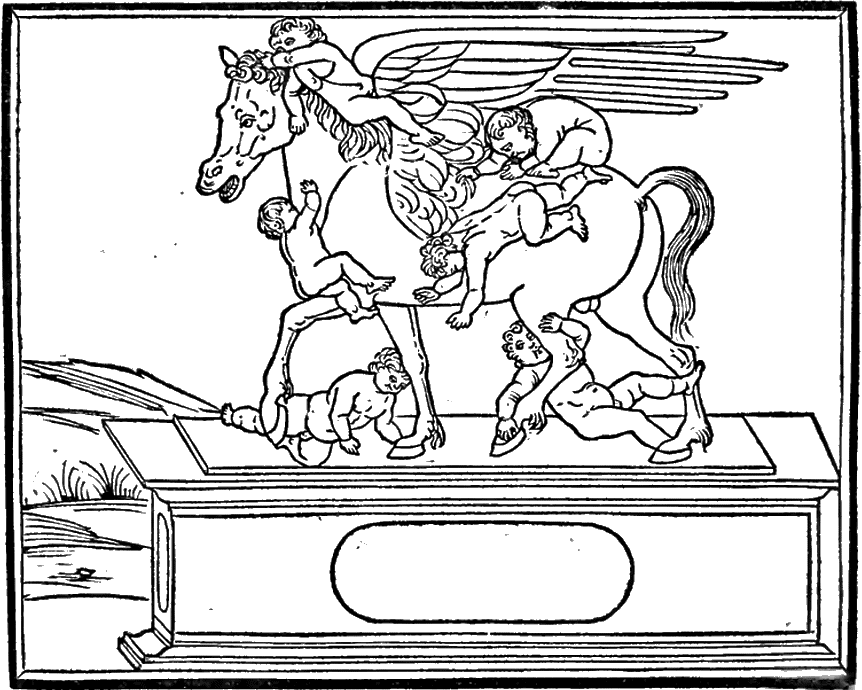
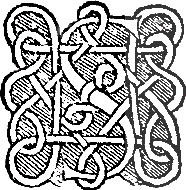 opra di questa piacia, dal initio intro verso la porta .x. passi, vidi uno prodigioso caballo et aligero Desultore, cum le ale passe di aeramento, di excessiva magnitudine. La ungula del quale occupava sopra la planicie dil basamento, nella extrema linea dilla rotundatione di uno calceo pedi .v. Et da questo extremo imo circinato di l’ungula, fina sotto il pecto, .ix. pedi per debita ragione alto io lo trovai. Cum il capo soluto et effrenato, cum due picole auricole, la una in ante porrecta, et l’altra retro contracta. Cum undiculate iube et prolixe, sopra il dextro del collo dependule. Sopra il quale molti adolescentuli a cavalcare dorsuariamente tentando. Niuno di essi fermo sopra retinerse valeva, per la sua soluta velocitate, et dura succussatura. Diqué alcuni cadevano, quali stavano praecipitabondi. Alcuni supini, et tali resupinati, et altri innixi ascendevano, tali involtati (rapiti nelle stringente mane) li longi crini vanamente tenivansi. Erano alcuni caduchi, in acto poscia di levarsi sotto il corpo lapsi dil excusore.
opra di questa piacia, dal initio intro verso la porta .x. passi, vidi uno prodigioso caballo et aligero Desultore, cum le ale passe di aeramento, di excessiva magnitudine. La ungula del quale occupava sopra la planicie dil basamento, nella extrema linea dilla rotundatione di uno calceo pedi .v. Et da questo extremo imo circinato di l’ungula, fina sotto il pecto, .ix. pedi per debita ragione alto io lo trovai. Cum il capo soluto et effrenato, cum due picole auricole, la una in ante porrecta, et l’altra retro contracta. Cum undiculate iube et prolixe, sopra il dextro del collo dependule. Sopra il quale molti adolescentuli a cavalcare dorsuariamente tentando. Niuno di essi fermo sopra retinerse valeva, per la sua soluta velocitate, et dura succussatura. Diqué alcuni cadevano, quali stavano praecipitabondi. Alcuni supini, et tali resupinati, et altri innixi ascendevano, tali involtati (rapiti nelle stringente mane) li longi crini vanamente tenivansi. Erano alcuni caduchi, in acto poscia di levarsi sotto il corpo lapsi dil excusore.
— fol. b4v.
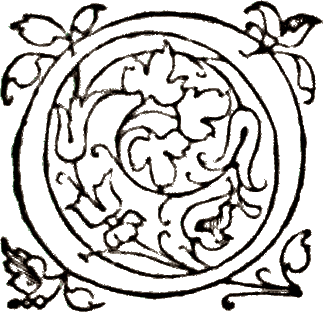 n this piazza, ten paces from its beginning toward the door, I saw a prodigious horse like a winged steed, made of bronze with its wings spread and of excessive size. One of its hooves covered a circle five feet in diameter on the surface of the base, and from this circle at the bottom of the hoof up to where the chest began, I found to be nine feet. Its head was free and unbridled, with two small ears, one pointed forwards, the other back, and a long, wavy mane falling down over the right-hand side of its neck. Many children were trying to ride on its back, but none of them could hold a firm seat because of the horse's great speed and hard jolting. Some of them were falling off, others ready to fall; some lay supine, others got up again and tried to remount. They grabbed the dense mane and wrapped their hands in it, vainly trying to hold on to the long hairs. Some of the fallen were trying to rise beneath the body that had shaken them off.
n this piazza, ten paces from its beginning toward the door, I saw a prodigious horse like a winged steed, made of bronze with its wings spread and of excessive size. One of its hooves covered a circle five feet in diameter on the surface of the base, and from this circle at the bottom of the hoof up to where the chest began, I found to be nine feet. Its head was free and unbridled, with two small ears, one pointed forwards, the other back, and a long, wavy mane falling down over the right-hand side of its neck. Many children were trying to ride on its back, but none of them could hold a firm seat because of the horse's great speed and hard jolting. Some of them were falling off, others ready to fall; some lay supine, others got up again and tried to remount. They grabbed the dense mane and wrapped their hands in it, vainly trying to hold on to the long hairs. Some of the fallen were trying to rise beneath the body that had shaken them off.
— Joscelyn Godwin: Hypnerotomachia Polifili. The Strife of Love in a Dream. London: Thames & Hudson, 2003. pp. 32-33.
Francesco Colonna
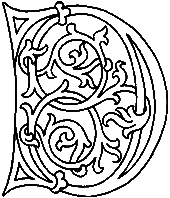 ie Zuschreibung der Hypnerotomachia an diesen Mönch stützt sich auf ein Exemplar, in das von einem Zeitgenossen das Nachfolgende eingetragen ist: « Der wirkliche Name des Autors ist Francesco Colonna, Venezianer, der dem Predigerorden angehört. Als er durch heiße Liebe zu einer gewissen Hippolyta in Treviso festgehalten wurde, nannte er diese mit verändertem Namen Polia und widmete ihr, wie ersichtlich, sein Werk. Die Kapitel des Buches beweisen dies. Denn die Anfangsbuchstaben eines jeden besagen, wenn man sie zusammenfügt: POLIAM FRATER FRANCISCUS COLUMNA PERAMAVIT. Er lebt noch in Venedig zu San Giovanni e Paolo. »
ie Zuschreibung der Hypnerotomachia an diesen Mönch stützt sich auf ein Exemplar, in das von einem Zeitgenossen das Nachfolgende eingetragen ist: « Der wirkliche Name des Autors ist Francesco Colonna, Venezianer, der dem Predigerorden angehört. Als er durch heiße Liebe zu einer gewissen Hippolyta in Treviso festgehalten wurde, nannte er diese mit verändertem Namen Polia und widmete ihr, wie ersichtlich, sein Werk. Die Kapitel des Buches beweisen dies. Denn die Anfangsbuchstaben eines jeden besagen, wenn man sie zusammenfügt: POLIAM FRATER FRANCISCUS COLUMNA PERAMAVIT. Er lebt noch in Venedig zu San Giovanni e Paolo. »
— Linus Birchler: Über die « Hypnerotomachia Poliphili ». In: Librarium, I, 1958, p. 38.
 oon after publication it was discovered that the first letter of each Chapter formed an acrostic which translates as: ‘Brother Francesco Colonna loved Polia immensely’. Note incidentally the past tense. Polia if she has been correctly identified had died of the plague in 1467. Other references have been found to Colonna in the text and this one might think would be the end of the question.
oon after publication it was discovered that the first letter of each Chapter formed an acrostic which translates as: ‘Brother Francesco Colonna loved Polia immensely’. Note incidentally the past tense. Polia if she has been correctly identified had died of the plague in 1467. Other references have been found to Colonna in the text and this one might think would be the end of the question.
But no. First there are two possible Francesco Colonnas. The one whom it is usually attributed to is Francesco Colonna, a monk from Venice, i. e. a Brother. The problem with him is that in spite of being a monk his life was characterized principally by extreme dissoluteness. He was continually being disciplined by his superiors. At the age of 82 for instance, he was involved in an incident in which he falsely accused others of being the perpetrators of rape. He was convicted and banished from Venice. He was a poor student in his youth and gives no indication of having the interest, the ability or the opportunity of acquiring the almost superhuman knowledge exhibited in the Poliphili.
Then there was Francesco Colonna from Rome who has a better claim in this last respect. He was a member of one of the most cultured families in the whole Renaissance; one member of the family had been Pope, another, Cardinal Prospero Colonna, was a learned patron of the arts, and possibly the inspiration for Prospero in the Tempest and another, Vittoria Colonna, was one of the great poets of the Renaissance. The Poliphili has obvious Roman connections since many of the buildings in the story have been identified as copies of Roman ruins. (...) But although this Roman Colonna appears to have had well-placed cultural connections, from what we know, he also appears to have been completely disinterested in literature or writing and so he is also discounted as the author.
Another high-level candidate for the authorship is Aldus himself and it does seem that he had some special sympathy with the events in the story since, like Polia, he also, just in the very year before the publication of the book, had been stricken by the plague and, like Polia, he had vowed that, if he survived, he would dedicate himself to God and thereafter live a monastic life. When he did recover, this idea was not so much to his liking, and he petitioned the Pope to relieve him from his vow and, fortunately for us, the Pope agreed.
— Robin Raybould: The Dream of Poliphilo. New York: Grolier Club, 9/30/2010, pp. 7-8.
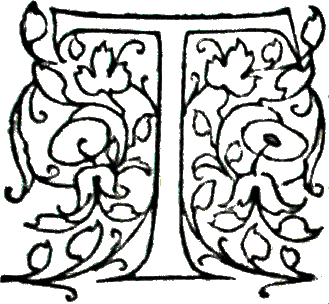 he systematic search for the book’s author did not begin until the 18th century. In 1723, the Venetian scholar Apostolo Zeno identified Francescus Columna as a monk in residence at the Dominican monastery of SS. Giovanni e Paolo in Venice, a claim based on a marginal note in a copy of the Poliphilo kept in a Dominican convent on the Giudecca. According to Zeno, the note stated that Colonna was in love with Hippolyta of the noble Trevisan Lellio family, or Polia, who died of a plague that ravaged Treviso in 1467. We will never know whether Zeno had gathered his information on Hippolyta from a marginal note or from the printed ‘epitaph’ that appears at the end of the Hypnerotomachia, which tells us that Polia died in Treviso on May 1, 1467. Indeed, the book that contained the ‘note’ never seems to have appeared again, and as Patricia Brown rightly speculates, whether or not Zeno ever saw the copy at all is questionable. Furthermore, we would add that marginal notes by their very nature raise a wide spectrum of problems. Whatever the source of Zeno’s ‘transcription,’ Zeno’s account counts among the first romantic interpretations of the Hypnerotomachia and its author.
he systematic search for the book’s author did not begin until the 18th century. In 1723, the Venetian scholar Apostolo Zeno identified Francescus Columna as a monk in residence at the Dominican monastery of SS. Giovanni e Paolo in Venice, a claim based on a marginal note in a copy of the Poliphilo kept in a Dominican convent on the Giudecca. According to Zeno, the note stated that Colonna was in love with Hippolyta of the noble Trevisan Lellio family, or Polia, who died of a plague that ravaged Treviso in 1467. We will never know whether Zeno had gathered his information on Hippolyta from a marginal note or from the printed ‘epitaph’ that appears at the end of the Hypnerotomachia, which tells us that Polia died in Treviso on May 1, 1467. Indeed, the book that contained the ‘note’ never seems to have appeared again, and as Patricia Brown rightly speculates, whether or not Zeno ever saw the copy at all is questionable. Furthermore, we would add that marginal notes by their very nature raise a wide spectrum of problems. Whatever the source of Zeno’s ‘transcription,’ Zeno’s account counts among the first romantic interpretations of the Hypnerotomachia and its author.
In 1959, the quest for Francesco Colonna blossomed in the wake of Giovanni Pozzi and M. T. Casella’s documentary reconstruction of the life of Francesco Colonna, author of the Hypnerotomachia and Dominican monk who resided in Venice, Treviso, and Padua, and lived his final days at the Monastery of SS. Giovanni e Paolo. Three years following the publication of Francesco Colonna’s biography, Pozzi and Lucia Ciapponi supported the attribution with an essay linking the woodcuts to the artistic milieu of Venice. In 1964, the same pair of scholars published the first critical edition of the Hypnerotomachia, a groundbreaking philological commentary on the diverse sources of the literary fragments that make up the text and an analysis of its complex language. The following year, Maurizio Calvesi countered Pozzi with an attribution to a new Francesco Colonna, member of the famous Roman Colonna family and Prince of Palestrina. Calvesi’s argument, developed through numerous articles and two books, tells the story of a Roman humanist in love with antiquity and Clarina Colonna, lady of Palestrina. Calvesi constructs a dense web of links, many of which remain circumstantial, among the classical and classicizing artistic motifs of Rome, Palestrina and the Hypnerotomachia.
Beyond Francesco Colonna (Veneziano or Romano), scholarship has yielded several other candidates, including Fra Eliseo da Treviso, Felice Feliciano da Verona, Lorenzo de’ Medici, and Leon Battista Alberti. The 1963 attribution to Fra Eliseo, a Servite monk born in Lucca who lived in Florence and breathed his last in Treviso, resembles the Francesco Colonna saga. Scholars in favor of Fra Eliseo have based their evidence upon an early 17th century speculation on the authorship of the Polifilo and Polia’s account of her Trevisan origins in book II. The remaining attributions are linked not with documentary evidence, the acrostic or Polia’s ‘history’; but rather, with subject matter found in the images and text. For example, one solution that predates Casella and Pozzi’s study proposes the 15th-century antiquarian, Felice Feliciano, as the author on the basis that Poliphilo’s imagined antiquities and inscriptions recall the fragments and epigraphic illustrations found in his syllogai. Similarly, a 1967 study, which located the hieroglyphs, inscriptions, and antique fragments of the Hypnerotomachia within the Neoplatonic ambiance of Renaissance Florence, attributed its authorship to none other than Lorenzo de’ Medici and identified Poliphilo and Polia as Lorenzo and his beloved Lucrezia Donati. The most recent proposal favors Leon Battista Alberti, an identification prompted by stylistic similarities and parallel motifs among the edifices described in the Polifilo and the treatises of Alberti. The attribution to an architect is perhaps more telling of the legacy of Tomasso Temanza’s 18th century biography, which named Francesco Colonna the first Venetian architect. In sum, although the origins of the text point toward Venice, evidence for all of the authors proposed remains inconclusive.
— April Oettinger: The Hypnerotomachia Poliphili: Image and Text in a Renaissance Romance. University of Virginia, 2000. pp. 2-6.
Hypnerotomachia
 er sperrige Titel hat mehrere Vorläufer: Die Batrachomyomachia (Kampf zwischen Fröschen und Mäusen) ist eine Parodie auf die Ilias aus hellenistischer Zeit, Prudentius Clemens (348-nach 405) schrieb die Psychomachia als allegorischen Kampf zwischen Tugenden und Lastern. Aldus Manutius selbst publizierte die Galeomyomachia (Kampf zwischen Katzen und Mäusen) des Theodoros Prodomus. (...) Der Autor lotet Ausdrucksmöglichkeiten der Sprache aus, bedient sich Text und Bild um zu enthüllen und zu verbergen und spielt mit Lehrsätzen der Rhetorik und literarischen Vorbildern. (...) Da das griechische ‚polios‘ ‚grau‘ und ‚Greis‘ bedeutet, ist Poliphil auch der Liebhaber des Alten oder der Antike. Darum beschreibt Poliphil ein Bauwerk, als habe er einen weiblichen Körper vor sich. Die Metapher vom Bauwerk als Körper bestimmt den Stil der Beschreibung, das Erleben von Architektur bekommt eine erotische Qualität. (...) Das Motiv der Wanderung mit Stationen der Prüfung findet sich auch in Dantes zwischen 1290 und 1321 entstandener Göttlicher Komödie. In diesem allegorischen Lehrgedicht wandert der Dichter durch Hölle, Fegefeuer und Himmel. Auf dem Weg zur Erlösung führen ihn Vergil und die Jugendliebe Beatrice. Weitere Grundlagen für die Hypnerotomachia sind Boccaccios Il Filocolo (um 1336) und L’amorosa visione (1342/43), sowie Petrarcas Triumphi (um 1352).28 Für Architekturtheorie und Architekturphantasien bilden Leon Battista Albertis De re aedificatoria libri X (erschienen 1485) und Filaretes Trattato di Architettura (vollendet 1464) den Hintergrund.
er sperrige Titel hat mehrere Vorläufer: Die Batrachomyomachia (Kampf zwischen Fröschen und Mäusen) ist eine Parodie auf die Ilias aus hellenistischer Zeit, Prudentius Clemens (348-nach 405) schrieb die Psychomachia als allegorischen Kampf zwischen Tugenden und Lastern. Aldus Manutius selbst publizierte die Galeomyomachia (Kampf zwischen Katzen und Mäusen) des Theodoros Prodomus. (...) Der Autor lotet Ausdrucksmöglichkeiten der Sprache aus, bedient sich Text und Bild um zu enthüllen und zu verbergen und spielt mit Lehrsätzen der Rhetorik und literarischen Vorbildern. (...) Da das griechische ‚polios‘ ‚grau‘ und ‚Greis‘ bedeutet, ist Poliphil auch der Liebhaber des Alten oder der Antike. Darum beschreibt Poliphil ein Bauwerk, als habe er einen weiblichen Körper vor sich. Die Metapher vom Bauwerk als Körper bestimmt den Stil der Beschreibung, das Erleben von Architektur bekommt eine erotische Qualität. (...) Das Motiv der Wanderung mit Stationen der Prüfung findet sich auch in Dantes zwischen 1290 und 1321 entstandener Göttlicher Komödie. In diesem allegorischen Lehrgedicht wandert der Dichter durch Hölle, Fegefeuer und Himmel. Auf dem Weg zur Erlösung führen ihn Vergil und die Jugendliebe Beatrice. Weitere Grundlagen für die Hypnerotomachia sind Boccaccios Il Filocolo (um 1336) und L’amorosa visione (1342/43), sowie Petrarcas Triumphi (um 1352).28 Für Architekturtheorie und Architekturphantasien bilden Leon Battista Albertis De re aedificatoria libri X (erschienen 1485) und Filaretes Trattato di Architettura (vollendet 1464) den Hintergrund.
— Daniel Theves: Die Hypnerotomachia Poliphili und ihr Titelbild in der französischen Ausgabe von 1561. Blackrock Digital LLC, 2018.
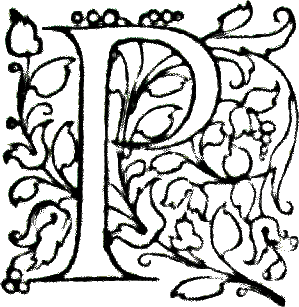 oliphilo’s dream of mental strife in the pursuit of love transports him to a pagan and polytheistic world. Sin has not yet entered in there, much less been linked to sex. The reason for Poliphilo’s anguish is that his own tutelary divinities are Cupid and Venus, whereas Polia, with whom he has fallen in love, begins as a chaste votary of the goddess Diana. When Polia transfers her allegiance to the same goddess as he, his battle is won, and the rest of his dream is unmitigated delight. There are few passages of the book that are not to some degree erotic, ...
oliphilo’s dream of mental strife in the pursuit of love transports him to a pagan and polytheistic world. Sin has not yet entered in there, much less been linked to sex. The reason for Poliphilo’s anguish is that his own tutelary divinities are Cupid and Venus, whereas Polia, with whom he has fallen in love, begins as a chaste votary of the goddess Diana. When Polia transfers her allegiance to the same goddess as he, his battle is won, and the rest of his dream is unmitigated delight. There are few passages of the book that are not to some degree erotic, ...
— Joscelyn Godwin: Hypnerotomachia Polifili. The Strife of Love in a Dream. London: Thames & Hudson, 2003. p. vii.
 The Hypnerotomachia is like a bible of this heretic religion, which used the prestige of classical learning to excuse its indulgence in eroticism and the celebration of an unfallen Nature.” (p. xvii) Solche Hieroglyphik der Renaissance enthält „eine reizvoll-verworrene Mischung aus agyptischer Bilderschrift und pythagoreischer Symbolik, antiker Mythologie und kabbalistischer Zahlenmystik, alttestamentlichen Motiven und mittelalterlicher Allegorese.
The Hypnerotomachia is like a bible of this heretic religion, which used the prestige of classical learning to excuse its indulgence in eroticism and the celebration of an unfallen Nature.” (p. xvii) Solche Hieroglyphik der Renaissance enthält „eine reizvoll-verworrene Mischung aus agyptischer Bilderschrift und pythagoreischer Symbolik, antiker Mythologie und kabbalistischer Zahlenmystik, alttestamentlichen Motiven und mittelalterlicher Allegorese.
— Arthur Henkel & Albrecht Schöne: Emblemata. Handbuch zur Sinnbildkunst des XVI. und XVII. Jahrhunderts. Stuttgart: Metzler, 1976. p. XI.
Diese Zusammenhänge waren den Renaissanceautoren bewußt, so lautet der Titel einer französischen Übersetzung: Le Tableau des riches inventions Couvertes du voile des feintes Amoureuses, qui sont representees dans le Songe de Poliphile Desvoilees des ombres du Songe, & subtilement exposees Par Beroalde. Paris: Matthieu Guillemot, 1600. — Die Welt erschloß sich demnach in Träumen, Symbolen, Hieroglyphen und Bildern, der Text folgte später und fließt quasi begleitend wie erstmals im Druck der Aldus-Ausgabe oder dieser kritischen um diese, respektive formt sich selbst als Bild, τεχνοπαíγνια, carmen figuratum.
 r selber hält ja ganze Beschreibungen der Baulichkeiten im Texte völlig im Styl einer Abhandlung über die res aedificatoria und bemüht sich, Vitruv’s Ton, termini technici zu treffen; es ist ein wahres Schaugericht gelehrter Ausdrücke und schwirrt von dı panglypho und hemiglypho, semiscalptura, scaphe, conchae etc., geometrische Entwürfe sind genau detaillirt u. a. m. (...) Im Allgemeinen bekundet das Buch in den gehäuften Anführungen aus Plinius, Vitruv u. A. ungemeine Belesenheit und Kenntniss der Stellen, welche über antike Monumente und deren Errichter, über Kunstwerke und Künstler Nachricht gaben. (...) Mit dem eigentlichen Hauptschmucke des Poliphil aber werden sich nur wenig Werke selbst aus jener Zeit der Holzschnitt-Illustration, dem 15. und 16. Jahrhundert, messen können. Von ihrem Kunstwerth wollen wir später reden, ihre Fülle aber allein schon ist ein der Bewunderung würdiges Moment; im Ganzen enthält das Werk 172 Holzschnitte, von denen mehrere die Grösse der Seiten haben. Wie in den Zeichnungen selbst, fassen sich auch in dem Schnitte zwei Hände erkennen, von denen die geschicktere überhaupt die grösseren Darstellungen und insbesondere die des zweiten Buches gefertigt zu haben scheint.
r selber hält ja ganze Beschreibungen der Baulichkeiten im Texte völlig im Styl einer Abhandlung über die res aedificatoria und bemüht sich, Vitruv’s Ton, termini technici zu treffen; es ist ein wahres Schaugericht gelehrter Ausdrücke und schwirrt von dı panglypho und hemiglypho, semiscalptura, scaphe, conchae etc., geometrische Entwürfe sind genau detaillirt u. a. m. (...) Im Allgemeinen bekundet das Buch in den gehäuften Anführungen aus Plinius, Vitruv u. A. ungemeine Belesenheit und Kenntniss der Stellen, welche über antike Monumente und deren Errichter, über Kunstwerke und Künstler Nachricht gaben. (...) Mit dem eigentlichen Hauptschmucke des Poliphil aber werden sich nur wenig Werke selbst aus jener Zeit der Holzschnitt-Illustration, dem 15. und 16. Jahrhundert, messen können. Von ihrem Kunstwerth wollen wir später reden, ihre Fülle aber allein schon ist ein der Bewunderung würdiges Moment; im Ganzen enthält das Werk 172 Holzschnitte, von denen mehrere die Grösse der Seiten haben. Wie in den Zeichnungen selbst, fassen sich auch in dem Schnitte zwei Hände erkennen, von denen die geschicktere überhaupt die grösseren Darstellungen und insbesondere die des zweiten Buches gefertigt zu haben scheint.
— Albert Ilg: Uber den kunsthistorischen Werth der Hypnerotomachia Poliphili. Wien: W. Braumuller, 1872. pp. 30, 53 & 94.
Und diese Bilder benötigen Interpretation auf mehreren Ebenen:
 he woodcuts of the Hypnerotomachia alone show more than eighty variations of festina lente, each one of them giving a new twist to the theme. Some of the designs are frankly comical, like the image of elephants turning into ants, and of ants into elephants, which demonstrates, on the authority of Sallust X, vi, a discordia concors between maximum and minimum. Others are solemn, for example the obelisk of three facets, which bears triadic images and inscriptions relating the Holy Trinity to the three parts of Time. Still others are puzzles for the eye: there is the half-seated, half-rising figure of a girl who has placed one foot firmly on the ground while lifting the other high into the air. On the side of the stationary foot she holds a pair of wings, on the side of the lifted foot a tortoise. The inscription informs us that she rises on the side of the tortoise to counteract its slowness, and at the same time remains seated on the side of the wings to offset their speed. And we are invited to do likewise: ‘Velocitatem sedendo, tarditatem tempera surgendo.’ The union of contraries is here ciphered through an extravagant contrapost, whose very absurdity makes the image memorable. Through such ciphers, which entertain while they instruct, the hero of the Hypnerotomachia is cautiously and alluringly guided towards the more hidden arcana, learning on his way to combine prudence with daring. The plan of the novel, so often quoted and so little read, is to ‘initiate’ the soul into its own secret destiny — the final union of Love and Death, for which Hypneros (the sleeping Éros funéraire) served as a poetic image. The way leads through a series of bitter-sweet progressions where the very first steps already foreshadow the ultimate mystery of Adonia, which is the sacred marriage of Pleasure and Pain.
he woodcuts of the Hypnerotomachia alone show more than eighty variations of festina lente, each one of them giving a new twist to the theme. Some of the designs are frankly comical, like the image of elephants turning into ants, and of ants into elephants, which demonstrates, on the authority of Sallust X, vi, a discordia concors between maximum and minimum. Others are solemn, for example the obelisk of three facets, which bears triadic images and inscriptions relating the Holy Trinity to the three parts of Time. Still others are puzzles for the eye: there is the half-seated, half-rising figure of a girl who has placed one foot firmly on the ground while lifting the other high into the air. On the side of the stationary foot she holds a pair of wings, on the side of the lifted foot a tortoise. The inscription informs us that she rises on the side of the tortoise to counteract its slowness, and at the same time remains seated on the side of the wings to offset their speed. And we are invited to do likewise: ‘Velocitatem sedendo, tarditatem tempera surgendo.’ The union of contraries is here ciphered through an extravagant contrapost, whose very absurdity makes the image memorable. Through such ciphers, which entertain while they instruct, the hero of the Hypnerotomachia is cautiously and alluringly guided towards the more hidden arcana, learning on his way to combine prudence with daring. The plan of the novel, so often quoted and so little read, is to ‘initiate’ the soul into its own secret destiny — the final union of Love and Death, for which Hypneros (the sleeping Éros funéraire) served as a poetic image. The way leads through a series of bitter-sweet progressions where the very first steps already foreshadow the ultimate mystery of Adonia, which is the sacred marriage of Pleasure and Pain.
One of the symbols for patience in the Hypnerotomachia — a bucranium or ox-skull — recurs in a painting of Amor attributed to Titian, in which Love sets the wheel of Chance into motion. Love, thus put between the symbols of Chance and Patience, is himself engaged in ‘hastening slowly’, and so lives up to his Platonic character — the son of painful Want and resourceful Affluence. ‘He is always poor ... and like his mother he is always in distress. Like his father too ... he is always plotting ... bold, enterprising, strong, a mighty hunter, always weaving some intrigue or other, ... terrible as an enchanter, sorcerer, sophist. ... But that which is always flowing in is always flowing out, and so he is never in want and never in wealth.’ A perfect portrait of that desperate dialectician appears in an Italianate drawing of the sixteenth century ascribed to a German draughtsman. It shows the figure of an equilibristic Amor who has appropriated the sail and sphere of Fortuna. Propelled by the force of his own breath which he blows into the sail, he throws the weight of his body in the opposite direction, stemming his feet against the sphere that carries him forward. The demon driving the precarious engine is both its motor and its brake.
These contraries such unity do hold
Only to flatter fools and make them bold.
On the face of it, it would not seem unreasonable to cite Plato in support of a cunning folly, since his dialogues are filled with such contrarious characters. The philosopher who is both ignorant and knowing, the lover who is both wealthy and poor, the guardian who is both fierce and friendly (Republic 375), all would seem to exhibit a union of contraries. Yet Plato always criticized, in the Republic (436) as well as in the Symposium (187), the Heraclitean theory that opposites coincide; he regarded it as a verbal confusion. ‘The way up’ and ‘the way down’ may lead to the same point, but that does not make ‘up’ and ‘down’ identical. Laughter and tears, pleasure and pain, motion and rest, harmony and discord may become interfused in our experience, but this does not abolish the difference between them. In the ‘royal craft of weaving’, by which Plato illustrated the art of statesmanship, the fierce nature of man should form the warp while his pliant nature serves as the woof: ‘These, which are naturally opposed, she seeks to bind and weave together’ (Statesman 309), but that very attempt is based on the assumption that warp and woof are not the same. How to breed in man a dog-like capacity for being aggressive as well as friendly, remained among the most formidable problems of an ideal republic; for it was not in the common nature of things to produce it, and when it did occur, it was something of a miracle, not unlike the philosopher-king, whose wisdom would not be clouded by his power. (...)
For Ficino, however, to whom the mysteries of Plato were revealed through Plotinus, Proclus, and Dionysius, the difference between a conjunction and a coincidence of opposites was merely one of degree. He was confident that ‘our Plato in the Parmenides equally affirms and negates all possible opposites concerning the ultimate One’, and he attributed to Plato himself the opinion, of which there is no trace in Plato’s text, that ‘the Infinite and the End, which oppose each other when applied to particulars, are outside of particulars simply one and the same’: Infinitum igitur atque finis quae sunt in rebus opposita, extra res sunt ipsum simpliciter unum. On this theory of the ‘infinite end’, which is also to be regarded as the source of all being, the many conjunctions of opposites which Plato had favoured, could be understood as emanations from their coincidence in the supreme One. (...)
In the Hypnerotomachia, where the precious diction is an extreme instance of the bitter-sweet style in literature, the Great Jupiter himself blesses Amor in these very words [fol. l1r]: σύ μοι γλυϰύς τε ϰαὶ πιϰρός, ‘you are sweet for me and bitter’. By the power of love the immortal gods acquire a semblance of mortality, and beloved mortals survive their death because they live ‘entombed’ in the hearts of their lovers:
Felix Polia quae sepulta vivis. [fol. F3v]
— Edgar Wind: Pagan Mysteries in the Renaissance. New and enlarged edition. London: Faber and Faber, 1968. pp. 103-107, 163.
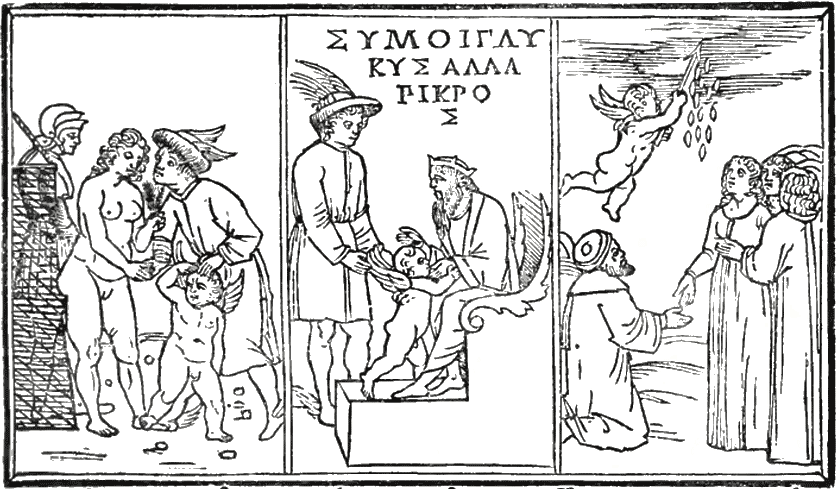
Es handelt sich also um eine komplexere Sprache als die gewöhnliche, sie setzt mehrschichtiges, labyrinthisches, bezugreiches Denken voraus. Die 172 Holzschnitte führten daneben ein faszinierendes Eigenleben, sie spielten während der vergangenen Jahrhunderte eine bedeutende Rolle als Depot bildlicher Vorlagen für Künstler, Dichter und Intellektuelle, wobei das volle Ausmaß ihres Einflusses schwer zu bestimmen ist.
 he role of the Hypnerotomachia in the 19th century quest for the Renaissance and the development of Renaissance studies has yet to be told. Indeed, Rossetti, Morris and Ruskin owned copies; Warburg corresponded with James Loeb about obtaining the first Aldine edition for his library; Burckhardt identified in the Polifilo the first pictures of antique ruins; and Symonds scrutinized the book’s hybrid language in his study of Renaissance literature. The 19th century also saw two new French editions and translations, along with an English facsimile, which appeared in 1904. In the 20th century, the enigmatic Polifilo stirred imaginations in the Surrealist movement and the Jungian school, and continues to mystify a group of scholars in search of the book’s elusive author. The 1499 Hypnerotomachia Poliphili, a masterpiece of the Renaissance, affords us a glimpse into the culture of Aldus’ generation, for Poliphilo’s romanticized vision of antiquity typifies Renaissance art and literature.
he role of the Hypnerotomachia in the 19th century quest for the Renaissance and the development of Renaissance studies has yet to be told. Indeed, Rossetti, Morris and Ruskin owned copies; Warburg corresponded with James Loeb about obtaining the first Aldine edition for his library; Burckhardt identified in the Polifilo the first pictures of antique ruins; and Symonds scrutinized the book’s hybrid language in his study of Renaissance literature. The 19th century also saw two new French editions and translations, along with an English facsimile, which appeared in 1904. In the 20th century, the enigmatic Polifilo stirred imaginations in the Surrealist movement and the Jungian school, and continues to mystify a group of scholars in search of the book’s elusive author. The 1499 Hypnerotomachia Poliphili, a masterpiece of the Renaissance, affords us a glimpse into the culture of Aldus’ generation, for Poliphilo’s romanticized vision of antiquity typifies Renaissance art and literature.
— April Oettinger: The Hypnerotomachia Poliphili: Image and Text in a Renaissance Romance. University of Virginia, 2000. p. 152.
EPITAPHIUM POLIAE
F œlix Polia, quæ sepulta vivis
C laro marte Poliphilus quiescens
I am fecit vigilare te sopitam.
EPITAPHIUM UBI POLIA LOQUITUR.
VIATOR FAC QUAESO MORULAM,
POLIAE NYMPHAE
HIC EST MYROPOLIUM.
QUAENAM INQUIES POLIA? FLOS
ILLE OMNEM REDOLENS VIRTUTEM
SPECTATISSIMUS.
QUI OB LOCI ARITUDINEM,
PLUSCULIS POLIPHILI LACHRYMULIS
REPULULESCERE NEQUIT.
AT SI ME FLORERE VIDERES, EXIMIA
PICTURA UNIVERSIS DECORITER
PRAESTARE CONSPICERES
PHOEBE INQUIENS,
QUEM INTACTUM URORE RELIQUERAS,
UMBRA CECIDIT.
HEU POLIPHILE DESINE.
FLOS SIC EXSICCATUS,
NUNQUAM REVIVISCIT.
VALE.
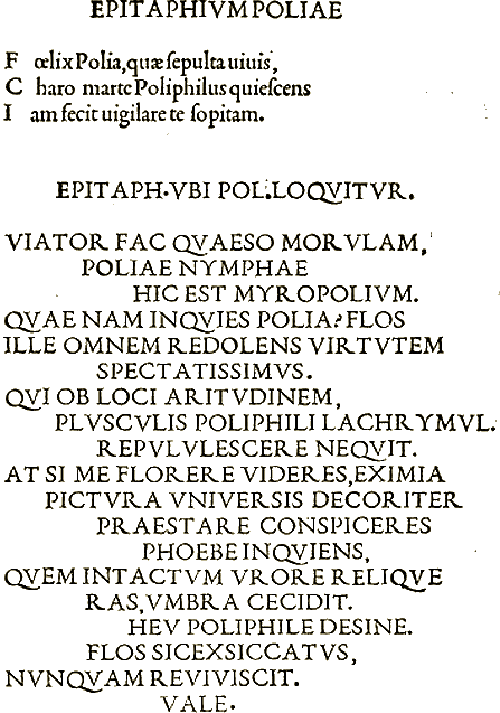
Die obigen Abbildungen zeigen den Holzschnitt auf fol. a3v zum ersten Kapitel, offensichtlich eine bildliche Anspielung auf die ersten Verse von Dantes Divina Comedia, die andere den häufig unterdrückten oder übermalten Holzschnitt auf fol. m6r.
Elektronische Faksimiles der Erstausgabe führt der ISTC ic00767000 an; ein schönes bietet die HAB.
Ein befreundeter Sammler stellte mir freundlicherweise ein Photo seines Exemplars
der späteren Aldus-Ausgabe zur Verfügung: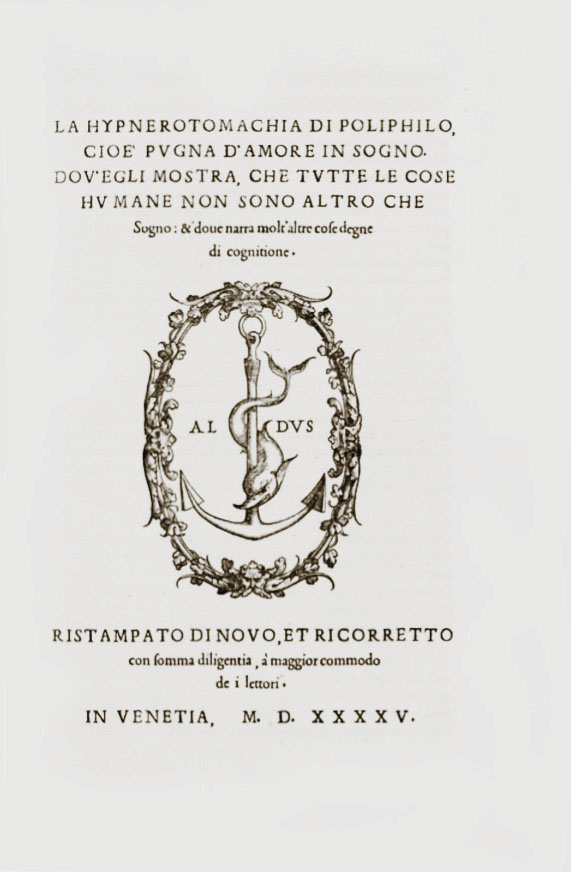
Die englische Übersetzung von Sir Robert Dallington erschien 1592, sie gibt nur etwa zwei Fünftel des Gesamttextes wieder.
Sprache
 here are few passages of the book that are not to some degree erotic, if we allow that Eros-Gupid-Amor is the god who fires us with the desire for beauty of every kind. When Poliphilo stands agape before the stupendous buildings of Antiquity, he seems to enjoy the same state of arousal as when he voyages to Cytherea in the company of Cupid, Polia and six exquisitely seductive sailor-nymphs. At every opportunity he indulges in an enumeration of detail that one might call fetishistic when he applies it to clothing or footwear, but which is no less obsessive when the object is an elaborate fountain or an emblematic obelisk. This polymorphous eroticism is what gives the Hypnerotomachia its intensity and its atmosphere, saturated with the desire to gaze, to taste, and to consume. (...)
here are few passages of the book that are not to some degree erotic, if we allow that Eros-Gupid-Amor is the god who fires us with the desire for beauty of every kind. When Poliphilo stands agape before the stupendous buildings of Antiquity, he seems to enjoy the same state of arousal as when he voyages to Cytherea in the company of Cupid, Polia and six exquisitely seductive sailor-nymphs. At every opportunity he indulges in an enumeration of detail that one might call fetishistic when he applies it to clothing or footwear, but which is no less obsessive when the object is an elaborate fountain or an emblematic obelisk. This polymorphous eroticism is what gives the Hypnerotomachia its intensity and its atmosphere, saturated with the desire to gaze, to taste, and to consume. (...)
Colonna’s originality lay in choosing a middle way, combining Italian syntax with a Latin vocabulary. He stretches his Italian constructions to the limit, with a breathless piling of clause upon clause that sometimes tumbles into incoherence. But they remain Italian, as do his lack of declensions, his use of articles and prepositions, and his verb-forms. His vocabulary, on the other hand, is not to be found in any Italian dictionary. Much of it consists of Latin words, the more recondite the better, which he adapts with Italian endings. A small but significant proportion of the words is Greek in origin. However, there is no substance to the oft-repeated rumour that the Hypnerotomachia also displays a knowledge of Hebrew, Arabic and Chaldean. Hebrew appears only in two inscriptions; a few Arabic words, in one.
Colonna derived his Latin vocabulary not only from well-known authors — Ovid, not surprisingly, being his favourite source both of words and ideas — but from the later Latin writers whom the Humanists disesteemed. His most abundant source was Apuleius’s novel Metamorphoses, or The Golden Ass, which is written in an extremely mannered style and filled with unfamiliar words, some of them unique to that writer. Apuleius’s combination of eroticism with pagan religiosity, and the structure of stories within stories, make the Golden Ass one of the most direct ancestors of the Hypnerotomachia. Equally important to Colonna’s project was the Natural History of Pliny the Elder, which served him as an inexhaustible source of words and anecdotes concerning plants, animals, minerals, technology, geography, history and curiosa.
The language of the Hypnerotomachia must have been almost as difficult for sixteenth-century readers as it is today. Fluency in Latin was much more common, but the standard education in the ‘better’ classics and the Latin of Catholic liturgy and the Vulgate cannot have been much help with Colonna’s extravagant vocabulary. Neither did those readers have dictionaries on their shelves to compare with modern ones. Then there are the strange botanical names drawn from obscure passages in Pliny’s encyclopedia, and the mass of classical references that are often even more obscure, coming at times from manuscript sources that betray themselves by corrupt forms of names. None of this was common knowledge. Colonna uses his erudition not to educate so much as to dazzle his audience, just as Poliphilo is dazzled by the highly-polished and over-decorated surfaces of the monuments he sees, and by the overweening sumptuousness of clothing, feasting and entertainment in the land of his dream.
— Joscelyn Godwin: Hypnerotomachia Polifili. The Strife of Love in a Dream. London: Thames & Hudson, 2003. pp. vii-viii & ix-x.
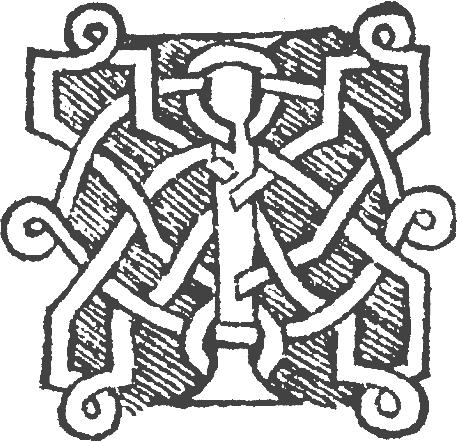 n Hypnerotomachia Poliphili, the list of examples of concinnitas are endless, such as the use of new combinations of languages including vernacular Italian, Tuscan, Latin, Greek, Hebrew, cryptic Arabic, imaginary Chaldean and hieroglyphs. Architectural combinations abound throughout the text including the first building that Poliphilo encounters a structure which combines a temple, triumphal arch, pyramid, obelisk, sphere, labyrinth, propylaeum (a gateway), part cave, part mountain, and part unidentified. Each building thereafter in the journey is also a combination of fragments which would have not been normally seen together, yet are freely joined to create the erotic environment that Poliphilo journeys through.
n Hypnerotomachia Poliphili, the list of examples of concinnitas are endless, such as the use of new combinations of languages including vernacular Italian, Tuscan, Latin, Greek, Hebrew, cryptic Arabic, imaginary Chaldean and hieroglyphs. Architectural combinations abound throughout the text including the first building that Poliphilo encounters a structure which combines a temple, triumphal arch, pyramid, obelisk, sphere, labyrinth, propylaeum (a gateway), part cave, part mountain, and part unidentified. Each building thereafter in the journey is also a combination of fragments which would have not been normally seen together, yet are freely joined to create the erotic environment that Poliphilo journeys through.
The plot of the allegory is also considered to have copied existing narratives in the romanzo d’amore tradition including Roman de la Rose, Filocolo, Divina commedia and Trionfi with borrowed passages from Boccaccio, Ovid, Jena de Meung, Petrarch, Dante, Diodorus Siculus, Horace, Catullus, Columella, Martial, Homer, Varro, Cicero, Gelllius, Virgil, Festus, Apuleius and Pliny.
As Lefaivre points out, the collecting and uniting of disparate ideas, architectural fragments and languages in the Hypnerotomachia Poliphili is an example of the recombinant design led by concinnitas, but I would like to propose that rather than leading to aesthetic value as she states, the treatise is an example of the constructive aspect of Aristotelian phantasia logistike in its craft of uniting and combining. That the whole treatise is a dreamwork, taking place in a dream within a dream only exaggerates its emphasis on the imagination, since no new sensory information is entering the mind of Poliphilo in his dormant state
Pérez-Gómez sees the treatise as an exemplar of the emerging individual imagination (poiesis) sitting comfortably with a given order of experience, a threshold between the ancient world of knowledge as given, and the emerging world of the active individual creative mind. As we see with other late quattrocento works such as Alberti’s de re Aedificatoria there is a new understanding, beginning with Alberti, that ancient precedents can be improved upon, rather than acting as absolute authority. Although Aristotle insisted that the imagination did not create new ideas , within his definition of the imagination, and in particular his phantasia logistike, we find the wiggle-room for an emerging creative act: re-making via uniting and combining. Concinnitas then defines the space of the emancipated individual imagination.
The Hypnerotomachia Poliphili is a critical text in the understanding of the imagination. Its defining feature is concinnitas, the excellence of uniting and combining fragments, which is the modus operandi of the Aristotelian phantasia logistike. The depth that these joined fragments are buried in the cryptic text is described by Crasso as being “devised his work so that only the wise may penetrate the sanctuary”, for “these things are not for the populace, not to be recited on the street-corners; they are drawn from the storehouses of philosophy and from the sources of the Muses, with the novelty of a language full of embellishments” The erotic tension of the space between parts and their joining, the fundamental act of architecture, serves as the foundation of imagination as described by Aristotle is nowhere better illuminated than in the quattrocento allegory of love, the Hypnerotomachia Poliphili.
— Sheryl Boyle: Hypnerotomachia Polyphili: the Five Senses and Aristotle’s Philosophy of Phantasia.
 t follows that Ficino’s praise of the Hieroglyphica of Horapollo, however interesting as a scholium to Plotinus (loc. cit., Opera, p. 1768), gives only an incomplete account of their Renaissance use. It is noticeable, for example, that while Plotinus had stressed the implicit understanding of hieroglyphs, and Ficino had praised them for their power of contracting many thoughts into one single form, those who designed ‘authentic hieroglyphs’ after classical monuments were particularly attracted by the reverse possibility, that of expanding the symbols into an additive picture-script, whose parts were to be read like words and sentences of a discursive language; cf. Hülsen, Le ilustrazioni della ‘Hypnerotomachia Polifili’ e le antichita di Roma, Bibliofila XII (1910), pp. 172 f. figs. 22 f.; L. Volkmann, Bilderschriften der Renaissance (1923), p. 16, fig. 5. The Hypnerotomachia carried that method to extremes by translating Latin sentences, word by word, into hieroglyphic designs which, contrary to Ficino’s argument, consisted always of several symbols, never of one alone. Even the famous compound of anchor and dolphin for festina tarde was not left to itself, but juxtaposed to a circle, for semper, so as to produce a discursive sequence: ‘semper festina tarde’.
t follows that Ficino’s praise of the Hieroglyphica of Horapollo, however interesting as a scholium to Plotinus (loc. cit., Opera, p. 1768), gives only an incomplete account of their Renaissance use. It is noticeable, for example, that while Plotinus had stressed the implicit understanding of hieroglyphs, and Ficino had praised them for their power of contracting many thoughts into one single form, those who designed ‘authentic hieroglyphs’ after classical monuments were particularly attracted by the reverse possibility, that of expanding the symbols into an additive picture-script, whose parts were to be read like words and sentences of a discursive language; cf. Hülsen, Le ilustrazioni della ‘Hypnerotomachia Polifili’ e le antichita di Roma, Bibliofila XII (1910), pp. 172 f. figs. 22 f.; L. Volkmann, Bilderschriften der Renaissance (1923), p. 16, fig. 5. The Hypnerotomachia carried that method to extremes by translating Latin sentences, word by word, into hieroglyphic designs which, contrary to Ficino’s argument, consisted always of several symbols, never of one alone. Even the famous compound of anchor and dolphin for festina tarde was not left to itself, but juxtaposed to a circle, for semper, so as to produce a discursive sequence: ‘semper festina tarde’.
— Edgar Wind: Pagan Mysteries in the Renaissance. New and enlarged edition. London: Faber and Faber, 1968. p. 208.
Inhaltsangabe
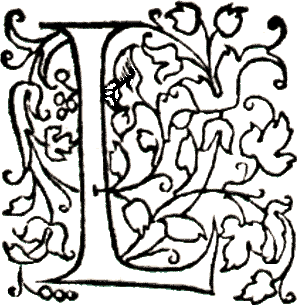 ector si tu desideri intendere brevemente quello che in quest’opera se contiene, Sapi che Poliphilo narra havere in somno visto mirande cose, la quale opera ello per vocabulo graeco la chiama pugna d’amor in somno. Ove lui finge havere visto molte cose antiquarie digne di memoria, & tutto quello lui dice havere visto di puncto in puncto & per proprii vocabuli ello descrive cum elegante stilo, Pyramide, Obelisci, Ruine maxime di edificii. La differentia di columne la sua mensura, gli capitelli, base, epistyli, cioè trabi recti, trabi inflexi, zophori, cioè frisii, coronice cum gli sui ornati. Vno magno caballo. Vno maximo elephanto. Vno colosso, una porta magnifica, cum le mensure & li sui ornamenti, uno spavento, li cinque sentimenti in cinque Nymphe uno egregio bagno, fontane, el palatio della regina che è el libero arbitrio. Uno regio pasto & superexcellente. La varietate di zoie overo petre pretiose & la sua natura. Vno gioco de scachi in ballo a tre mensure de soni. Tre giardini, uno di vitro, uno di seta, uno in laberyntho che è la vita humana uno peristylio latericio, Ove in medio era expressa la trinitate in figure hieroglyphe, cioe sacre scalpture aegyptie. Le tre porte in quale lui rimanse Polia come era di habito & habitudine. Polia el conduce a mirare quatro triumphi mirandi di Iove, le amorose deli Dei. Quelle di poeti, l’affecto & effecto d’amore vario. El triumpho di Vertumno cum Pomona. El sacrificio all’antica di Priapo, uno maraveglioso tempio per arte descripto. Ove furon facti sacrificii cum mirabili riti & religione. Come Polia & lui andorono allo littore aspectare Cupidine, ove era uno tempio destructo. Nel quale Polia suade a Poliphilo el vadi intro a mirare le cose antiche. Et quivi vide molti epitaphii, uno inferno depincto di musaico. Como per spavento de qui se partì & vene da Polia. Et quivi stanti vene Cupidine cum la navicula da sei Nymphe remigata. Nella quale ambo intrati, Amor fece vela cum le sue ale. Et quivi dagli Dii marini & Dee, & Nymphe & monstri li fu facto honore a Cupidine, giunseron all’insula Cytherea, la quale Poliphilo distincto in boschetti, prati, horti, & fiumi, & fonti plenamente la descrive, & li presenti fu fatti a Cupidine & lo accepto dalle Nymphe, & come sopra uno carro triumphante andorono ad uno mirando theatro tuto descripto. In mezo del’insula. Nel mezo dil quale è il fonte venereo di sete columne pretiose, & tutto che ivi fu facto, & venendo Marte d’indi se partirono & andorono al fonte, ove era la sepultura di Adone. Et qui narrano le Nymphe lo anniversario che in memoria faceva Venere. Suadeno poscia le Nymphe a Polia che la narri la sua origine & el suo inamorare. & questo nel primo libro. Nel secondo Polia narra el suo parentato, la aedificatione de Tarviso, la difficultate del suo inamoramento, & lo foelice exito, & compita la historia cum infiniti & dignissimi accessorii & correlarii, al canto dilla philomela se sveglioe. Vale.
ector si tu desideri intendere brevemente quello che in quest’opera se contiene, Sapi che Poliphilo narra havere in somno visto mirande cose, la quale opera ello per vocabulo graeco la chiama pugna d’amor in somno. Ove lui finge havere visto molte cose antiquarie digne di memoria, & tutto quello lui dice havere visto di puncto in puncto & per proprii vocabuli ello descrive cum elegante stilo, Pyramide, Obelisci, Ruine maxime di edificii. La differentia di columne la sua mensura, gli capitelli, base, epistyli, cioè trabi recti, trabi inflexi, zophori, cioè frisii, coronice cum gli sui ornati. Vno magno caballo. Vno maximo elephanto. Vno colosso, una porta magnifica, cum le mensure & li sui ornamenti, uno spavento, li cinque sentimenti in cinque Nymphe uno egregio bagno, fontane, el palatio della regina che è el libero arbitrio. Uno regio pasto & superexcellente. La varietate di zoie overo petre pretiose & la sua natura. Vno gioco de scachi in ballo a tre mensure de soni. Tre giardini, uno di vitro, uno di seta, uno in laberyntho che è la vita humana uno peristylio latericio, Ove in medio era expressa la trinitate in figure hieroglyphe, cioe sacre scalpture aegyptie. Le tre porte in quale lui rimanse Polia come era di habito & habitudine. Polia el conduce a mirare quatro triumphi mirandi di Iove, le amorose deli Dei. Quelle di poeti, l’affecto & effecto d’amore vario. El triumpho di Vertumno cum Pomona. El sacrificio all’antica di Priapo, uno maraveglioso tempio per arte descripto. Ove furon facti sacrificii cum mirabili riti & religione. Come Polia & lui andorono allo littore aspectare Cupidine, ove era uno tempio destructo. Nel quale Polia suade a Poliphilo el vadi intro a mirare le cose antiche. Et quivi vide molti epitaphii, uno inferno depincto di musaico. Como per spavento de qui se partì & vene da Polia. Et quivi stanti vene Cupidine cum la navicula da sei Nymphe remigata. Nella quale ambo intrati, Amor fece vela cum le sue ale. Et quivi dagli Dii marini & Dee, & Nymphe & monstri li fu facto honore a Cupidine, giunseron all’insula Cytherea, la quale Poliphilo distincto in boschetti, prati, horti, & fiumi, & fonti plenamente la descrive, & li presenti fu fatti a Cupidine & lo accepto dalle Nymphe, & come sopra uno carro triumphante andorono ad uno mirando theatro tuto descripto. In mezo del’insula. Nel mezo dil quale è il fonte venereo di sete columne pretiose, & tutto che ivi fu facto, & venendo Marte d’indi se partirono & andorono al fonte, ove era la sepultura di Adone. Et qui narrano le Nymphe lo anniversario che in memoria faceva Venere. Suadeno poscia le Nymphe a Polia che la narri la sua origine & el suo inamorare. & questo nel primo libro. Nel secondo Polia narra el suo parentato, la aedificatione de Tarviso, la difficultate del suo inamoramento, & lo foelice exito, & compita la historia cum infiniti & dignissimi accessorii & correlarii, al canto dilla philomela se sveglioe. Vale.
— Ausgabe 1499, fol. 3r.
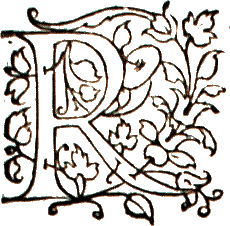 eader, if you wish to hear briefly what is contained in this work, know that Poliphilo tells that he saw remarkable things in a dream, hence he calls the work in Greek words ‘the strife of love in a dream.’ He represents himself as having seen many ancient things worthy of memory, and everything that he says he has seen, he describes point by point in the appropriate terms and in an elegant style: pyramids, obelisks, huge ruins of buildings, the varieties of columns, their measurements, capitals, bases, epistyles or straight beams, bent beams, zophori or friezes, and cornices with their ornaments. There is a great horse, an enormous elephant, a colossus, a magnificent portal with its measurements and ornaments, a fright, the five senses represented in five nymphs, a remarkable bath, fountains, the palace of the queen who is Freewill, and an excellent royal feast. He tells of the variety of gems or precious stones, and their nature; a game of chess in a ballet with music in triple time; three gardens, one of glass, one of silk and one a labyrinth, which is human life; a peristyle of brick in whose centre the Trinity was expressed in hieroglyphic figures, that is, in the sacred engraving of the Egyptians; the three portals before which he tarried; Polia, her appearance and behaviour. Then Polia leads him to watch four wonderful triumphs of Jupiter, the women loved by the gods and by the poets, the various affects and effects of love; the triumph of Vertumnus with Pomona; the sacrifice to Priapus, in ancient style; a marvellous temple, artistically described, where sacrifices were made with miraculous rites and religion. Then how he went with Polia to await Cupid at the shore, where there was a ruined temple, at which Polia persuades Poliphilo to go inside and admire the antiquities. Here he sees many epitaphs and an inferno depicted in mosaic. How he was frightened, and left them to return to Polia. And as they were standing there, Cupid arrived with the boat rowed by six nymphs, on to which they both went, and Amor made a sail with his wings. Then honours were paid to Cupid by the sea-gods and goddesses, the nymphs and monsters. They reached the island of Cytherea, which Poliphilo describes fully as divided into groves, meadows, gardens, streams and springs. Presentations were made to Cupid, and he was welcomed by the nymphs, then they went on a triumphal chariot to a wonderful theatre, all described, in the middle of the island. In its centre is Venus’s fountain with seven precious columns. He tells of all that happened there, and how when Mars arrived they left and went to the spring where Adonis’s tomb was; and there the nymphs tell of the anniversary that Venus kept in his memory. Then the nymphs persuade Polia to tell of her origin and her falling in love; and that is the first book. In the second, Polia tells of her ancestry, the building of Treviso, the difficulties of her falling in love and their happy conclusion. The story is filled with innumerable and suitable details and correlations, then at the song of the nightingale he awoke. Farewell.
eader, if you wish to hear briefly what is contained in this work, know that Poliphilo tells that he saw remarkable things in a dream, hence he calls the work in Greek words ‘the strife of love in a dream.’ He represents himself as having seen many ancient things worthy of memory, and everything that he says he has seen, he describes point by point in the appropriate terms and in an elegant style: pyramids, obelisks, huge ruins of buildings, the varieties of columns, their measurements, capitals, bases, epistyles or straight beams, bent beams, zophori or friezes, and cornices with their ornaments. There is a great horse, an enormous elephant, a colossus, a magnificent portal with its measurements and ornaments, a fright, the five senses represented in five nymphs, a remarkable bath, fountains, the palace of the queen who is Freewill, and an excellent royal feast. He tells of the variety of gems or precious stones, and their nature; a game of chess in a ballet with music in triple time; three gardens, one of glass, one of silk and one a labyrinth, which is human life; a peristyle of brick in whose centre the Trinity was expressed in hieroglyphic figures, that is, in the sacred engraving of the Egyptians; the three portals before which he tarried; Polia, her appearance and behaviour. Then Polia leads him to watch four wonderful triumphs of Jupiter, the women loved by the gods and by the poets, the various affects and effects of love; the triumph of Vertumnus with Pomona; the sacrifice to Priapus, in ancient style; a marvellous temple, artistically described, where sacrifices were made with miraculous rites and religion. Then how he went with Polia to await Cupid at the shore, where there was a ruined temple, at which Polia persuades Poliphilo to go inside and admire the antiquities. Here he sees many epitaphs and an inferno depicted in mosaic. How he was frightened, and left them to return to Polia. And as they were standing there, Cupid arrived with the boat rowed by six nymphs, on to which they both went, and Amor made a sail with his wings. Then honours were paid to Cupid by the sea-gods and goddesses, the nymphs and monsters. They reached the island of Cytherea, which Poliphilo describes fully as divided into groves, meadows, gardens, streams and springs. Presentations were made to Cupid, and he was welcomed by the nymphs, then they went on a triumphal chariot to a wonderful theatre, all described, in the middle of the island. In its centre is Venus’s fountain with seven precious columns. He tells of all that happened there, and how when Mars arrived they left and went to the spring where Adonis’s tomb was; and there the nymphs tell of the anniversary that Venus kept in his memory. Then the nymphs persuade Polia to tell of her origin and her falling in love; and that is the first book. In the second, Polia tells of her ancestry, the building of Treviso, the difficulties of her falling in love and their happy conclusion. The story is filled with innumerable and suitable details and correlations, then at the song of the nightingale he awoke. Farewell.
— Translated by Joscelyn Godwin: Hypnerotomachia Polifili. The Strife of Love in a Dream. London: Thames & Hudson, 2003. pp. 5-6.
Lucius Apuleius & Francesco Colonna
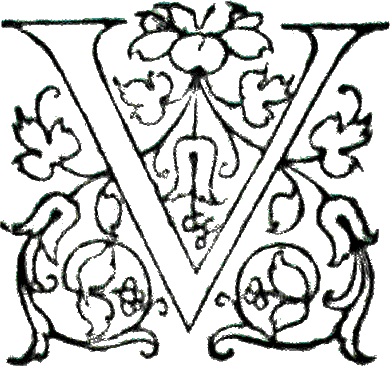 erum hæc omnis distributio eorum dæmonum fuit, qui quondam in corpore humano fuere. Sunt autem non posteriore numero, præstantiore longe dignitate, superius aliud, augustius genus dæmonum, qui semper a corporis conpedibus et nexibus liberi certis potestatibus curant. Quorum e numero Somnus atque Amor diversam inter se vim possident, Amor vigilandi, Somnus soporandi. Ex hac igitur sublimiore dæmonum copia Plato autumat (singulis) hominibus in vita agenda testes et custodes singulis additos, qui nemini conspicui semper adsint arbitri omnium non modo actorum verum etiam cogitatorum. At ubi vita edita remeandum est, eundem illum, qui nobis præditus fuit, raptare ilico et trahere veluti custodiam suam ad iudicium atque illic in causa dicunda adsistere, si qua commentiatur, redarguere, si qua vera dicat, adseverare, prorsus illius testimonio ferri sententiam. Proinde vos omnes, qui hanc Platonis divinam sententiam me interprete auscultatis, ita animos vestros ad quæcumque agenda vel meditanda formate, ut sciatis nihil homini præ istis custodibus nec intra animum nec foris esse secreti, quin omnia curiose ille participet; omnia visitet, omnia intellegat, in ipsis penitissimis mentibus vice conscientiæ deversetur. Hic, quem dico, privus custos, singularis præfectus, domesticus speculator, proprius curator, intimus cognitor, adsiduus observator, individuus arbiter, inseparabilis testis, malorum inprobator, bonorum probator, si rite animadvertatur, sedulo cognoscatur, religiose colatur, ita ut a Socrate iustitia et innocentia cultus est, in rebus incertis prospector, dubiis præmonitor, periculosis tutator, egenis opitulator, qui tibi queat tum insomniis, tum signis, tum etiam fortasse coram, cum usus postulat, mala averruncare, bona prosperare, humilia sublimare, nutantia fulcire, obscura clarare, secunda regere, adversa corrigere.
erum hæc omnis distributio eorum dæmonum fuit, qui quondam in corpore humano fuere. Sunt autem non posteriore numero, præstantiore longe dignitate, superius aliud, augustius genus dæmonum, qui semper a corporis conpedibus et nexibus liberi certis potestatibus curant. Quorum e numero Somnus atque Amor diversam inter se vim possident, Amor vigilandi, Somnus soporandi. Ex hac igitur sublimiore dæmonum copia Plato autumat (singulis) hominibus in vita agenda testes et custodes singulis additos, qui nemini conspicui semper adsint arbitri omnium non modo actorum verum etiam cogitatorum. At ubi vita edita remeandum est, eundem illum, qui nobis præditus fuit, raptare ilico et trahere veluti custodiam suam ad iudicium atque illic in causa dicunda adsistere, si qua commentiatur, redarguere, si qua vera dicat, adseverare, prorsus illius testimonio ferri sententiam. Proinde vos omnes, qui hanc Platonis divinam sententiam me interprete auscultatis, ita animos vestros ad quæcumque agenda vel meditanda formate, ut sciatis nihil homini præ istis custodibus nec intra animum nec foris esse secreti, quin omnia curiose ille participet; omnia visitet, omnia intellegat, in ipsis penitissimis mentibus vice conscientiæ deversetur. Hic, quem dico, privus custos, singularis præfectus, domesticus speculator, proprius curator, intimus cognitor, adsiduus observator, individuus arbiter, inseparabilis testis, malorum inprobator, bonorum probator, si rite animadvertatur, sedulo cognoscatur, religiose colatur, ita ut a Socrate iustitia et innocentia cultus est, in rebus incertis prospector, dubiis præmonitor, periculosis tutator, egenis opitulator, qui tibi queat tum insomniis, tum signis, tum etiam fortasse coram, cum usus postulat, mala averruncare, bona prosperare, humilia sublimare, nutantia fulcire, obscura clarare, secunda regere, adversa corrigere.
— Lucius Apuleius: De deo Socratis, XVI.
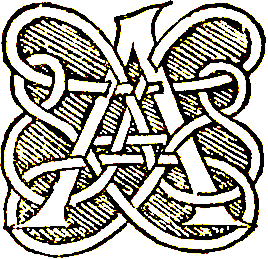 ll this distribution, however, was of those daemons, who once existed in a human body. But there is another species of daemons, more sublime and venerable, not less numerous, but far superior in dignity, who, being always liberated from the bonds and conjunction of the body, preside over certain powers. In the number of these are Sleep and Love, who possess powers of a different nature; Love, of exciting to wakefulness, but Sleep of lulling to rest. From this more sublime order of daemons, Plato asserts that a peculiar daemon is allotted to every man, who is a witness and a guardian of his conduct in life, who, without being visible to any one, is always present, and who is an arbitrator not only of his deeds, but also of his thoughts. But when, life being finished, the soul returns, then the daemon who presided over it immediately seizes, and leads it as his charge to judgement and is there present with it while it pleads its cause. Hence, this daemon reprehends it, if it has acted on any false pretence; solemnly confirms what it says, if it asserts any thing that is true; and conformably to its testimony passes sentence. All you, therefore, who hear this divine opinion of Plato, as interpreted by me, so form your minds to whatever you may do, or to whatever may be the subject of your meditation, that you may know there is nothing concealed from those guardians either within the mind, or external to it; but that the daemon who presides over you inquisitively participates of all that concerns you, sees all things, understands all things, and in the place of conscience dwells in the most profound recesses of the mind. For he of whom I speak is a perfect guardian, a singular prefect, a domestic speculator, a proper curator, an intimate inspector, an assiduous observer, an inseparable arbiter, a reprobater of what is evil, an approver of what is good; and if he is legitimately attended to, sedulously known, and religiously worshipped, in the way in which he was reverenced by Socrates with justice and innocence, will be a predictor in things uncertain, a premonitor in things dubious, a defender in things dangerous, and an assistant in want. He will also be able, by dreams, by tokens, and perhaps also manifestly, when the occasion demands it, to avert from you evil, increase your good, raise your depressed, support your falling, illuminate your obscure, govern your prosperous, and correct your adverse circumstances.
ll this distribution, however, was of those daemons, who once existed in a human body. But there is another species of daemons, more sublime and venerable, not less numerous, but far superior in dignity, who, being always liberated from the bonds and conjunction of the body, preside over certain powers. In the number of these are Sleep and Love, who possess powers of a different nature; Love, of exciting to wakefulness, but Sleep of lulling to rest. From this more sublime order of daemons, Plato asserts that a peculiar daemon is allotted to every man, who is a witness and a guardian of his conduct in life, who, without being visible to any one, is always present, and who is an arbitrator not only of his deeds, but also of his thoughts. But when, life being finished, the soul returns, then the daemon who presided over it immediately seizes, and leads it as his charge to judgement and is there present with it while it pleads its cause. Hence, this daemon reprehends it, if it has acted on any false pretence; solemnly confirms what it says, if it asserts any thing that is true; and conformably to its testimony passes sentence. All you, therefore, who hear this divine opinion of Plato, as interpreted by me, so form your minds to whatever you may do, or to whatever may be the subject of your meditation, that you may know there is nothing concealed from those guardians either within the mind, or external to it; but that the daemon who presides over you inquisitively participates of all that concerns you, sees all things, understands all things, and in the place of conscience dwells in the most profound recesses of the mind. For he of whom I speak is a perfect guardian, a singular prefect, a domestic speculator, a proper curator, an intimate inspector, an assiduous observer, an inseparable arbiter, a reprobater of what is evil, an approver of what is good; and if he is legitimately attended to, sedulously known, and religiously worshipped, in the way in which he was reverenced by Socrates with justice and innocence, will be a predictor in things uncertain, a premonitor in things dubious, a defender in things dangerous, and an assistant in want. He will also be able, by dreams, by tokens, and perhaps also manifestly, when the occasion demands it, to avert from you evil, increase your good, raise your depressed, support your falling, illuminate your obscure, govern your prosperous, and correct your adverse circumstances.
— On the God of Socrates, translated by Thomas Taylor.
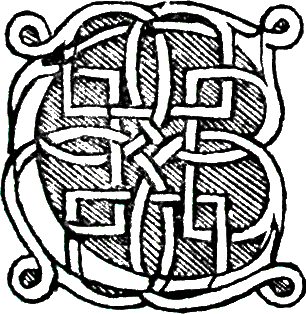 olonna derived his Latin vocabulary not only from well-known authors — Ovid, not surprisingly being his favourite source both of words and ideas — but from the later Latin writers whom the Humanists disesteemed. His most abundant source was Apuleius’ novel Metamorphoses, or The Golden Ass, which is written in an extremely mannered style and filled with unfamilar words, some of them unique to that writer. Apuleius’ combination of eroticism with pagan religiosity, and the structure of stories within stories, make the Golden Ass one of the most direct ancestors of the Hypnerotomachia. Equally important to Colonna’s project was the Natural History of Pliny the Elder, which served him as an inexhaustible source of words and anecdotes concerning plants, animals, minerals, technology, geography, history and curiosa.
olonna derived his Latin vocabulary not only from well-known authors — Ovid, not surprisingly being his favourite source both of words and ideas — but from the later Latin writers whom the Humanists disesteemed. His most abundant source was Apuleius’ novel Metamorphoses, or The Golden Ass, which is written in an extremely mannered style and filled with unfamilar words, some of them unique to that writer. Apuleius’ combination of eroticism with pagan religiosity, and the structure of stories within stories, make the Golden Ass one of the most direct ancestors of the Hypnerotomachia. Equally important to Colonna’s project was the Natural History of Pliny the Elder, which served him as an inexhaustible source of words and anecdotes concerning plants, animals, minerals, technology, geography, history and curiosa.
The language of the Hypnerotomachia must have been almost as difficult for sixteenth-century readers as it is today. Fluency in Latin was much more common, but the standard education in the ‘better’ classics and the Latin of Catholic liturgy and the Vulgate cannot have been much help with Colonna’s extravagant vocabulary. Neither did those readers have dictionaries on their shelves to compare with modern ones. Then there are the strange botanical names drawn from obscure passages in Pliny’s encyclopedia, and the mass of classical references that are often even more obscure, coming at times from manuscript sources that betray themselves by corrupt forms of names. None of this was common knowledge. Colonna uses his erudition not to educate so much as to dazzle his audience, just as Poliphilo is dazzled by the highly-polished and over-decorated surfaces of the monuments he sees, and by the overweening sumptuousness of clothing, feasting and entertainment in the land of his dream. (...)
Each of the two books has its own climax. That of Book One takes place at the Fountain of Venus in the centre of the Isle of Cytherea, where Polifilo usus Cupid’s arrow to tear the curtain that conceals the naked Goddess (fol. z1r), and is then pierced by an arrow himself. Superficially, this recalls the symbolic deflowerment at the end of the Romance of the Rose, but a closer analogy is the epiphanic Book XI of Apuleius’ Metamorphoses in which Lucius, restored from donkey to man again, witnesses the Mysteries of Isis and Osiris and beholds the Goddess in her visible form.
— Joscelyn Godwin: Hypnerotomachia Polifili. The Strife of Love in a Dream. London: Thames & Hudson, 2003. pp. x & xii.
Marginalia by two contemporary hands in the copy of the Hypnerotomachia Polifili first edition of the Biblioteca degli Intronati di Siena.
fol. a3v. and fol. a2r.
 oliphilus, indulgens voluptati et delascivo amori, deperdit viam virtutis sequebaturque ignorantiam fomitem errorum (...)
oliphilus, indulgens voluptati et delascivo amori, deperdit viam virtutis sequebaturque ignorantiam fomitem errorum (...)
Apuleius platonicæ disciplinæ imitator multa varia et nephanda se vidisse scribit, dum corium asininum indutum fingat, profecto ne insimularetur, comodo ea vidisset quæ nepharium est coram hominibus perpetrare et palam narare. Scimus enim iumenta homines in agendis sceleribus nequaquam vereri, verentur vero hominum aspectus: iccirco finxit se asinum ad tot delatus (sic) erumnas, cui non erat respectus: igitur ubicumque ut asinus assistebat, ea in eius aspectu fiebat (sic), quæ nequaquam in præsentia hominum agerentur. Poliphilus, imitator Apulegii, volens igitur narare multa et varia, quæ homini realiter apparere non possunt, igitur non forma beluina tectus voluit manifestare se vidisse quæ naraturus est, sed in somno et non realiter. Nihilominus cuncta quæ in somno se vidisse recitat, narat tamquam si cuncta realiter et sensibus vidisset descenditque ad particulas, quod factum ab aliquo non habetur observatum, nisi a Luciano in quibusdam picturis.
— Edoardo Fumagalli: Due esemplari dell’ Hypnerotomachia Poliphili di Francesco Colonna, Aevum 66, 1992, p. 430.
 oliphilo, indulging in pleasure and lascivious love, loses the way of virtue and began to follow ignorance, the kindling-wood of errors (...)
oliphilo, indulging in pleasure and lascivious love, loses the way of virtue and began to follow ignorance, the kindling-wood of errors (...)
Apuleius, an imitator of Platonic teaching, writes that he saw many diverse and unmentionable things while clad, as he feigns, in the hide of an ass, assuredly to avoid being interrogated as to how he managed to see things which it is a crime to commit and narrate openly in the presence of men. For we know that men, when they are committing crimes, do not fear beasts of burden at all; but they do fear the gaze of humans. For that reason, he feigned himself an ass, subjected to so many hardships — an ass to which no regard was paid. Therefore, wherever he was an asinine bystander, things went on beneath his gaze which would never have been done in the presence of humans. Poliphilus, an imitator of Apuleius, wanting therefore to relate diverse and varied things which could not appear to a man in reality, therefore wanted to make clear that he had seen what he was about to relate, not hidden in the shape of a beast, but in a dream and not in real life. Nonetheless, everything that he tells us that he saw in a dream, he relates as if he had seen it in real life and with his senses, and he comes down to small details, which has not been observed being done by anyone, except by Lucian in some of his sketches.
— Translated by Robert H. F. Carver: The Protean Ass. Oxford: U. P., 2007. p. 192.
 oliphilus imitator L. Apul. volens narrare multa et varia quæ homini realiter aparere non possunt, non forma beluina tectus, sed somno oppressus, multa se vidisse commemorat tanquam si cuncta sensibus subiecta vidisset descenditque ad minima et particularia describenda, Lucium ac Lucianum in suis fictis narrationibus imitatus, ut humana omnia quæ sensibiliter seu ymaginarie comprehenduntur non nisi somnium esse demonstrat, etc.
oliphilus imitator L. Apul. volens narrare multa et varia quæ homini realiter aparere non possunt, non forma beluina tectus, sed somno oppressus, multa se vidisse commemorat tanquam si cuncta sensibus subiecta vidisset descenditque ad minima et particularia describenda, Lucium ac Lucianum in suis fictis narrationibus imitatus, ut humana omnia quæ sensibiliter seu ymaginarie comprehenduntur non nisi somnium esse demonstrat, etc.
— Edoardo Fumagalli: Due esemplari dell’ Hypnerotomachia Poliphili di Francesco Colonna, Aevum 66, 1992, p. 430.
 oliphilus, an imitator of Apuleius, wanting to relate many and varied things which could not appear to a man in reality, recalls that he saw many things — not hidden in the shape of a beast, but overcome by a dream — as if all the things that he had seen had been comprehended by the senses; and he comes down to the smallest details and particulars, having imitated Lucius and Lucian in their
oliphilus, an imitator of Apuleius, wanting to relate many and varied things which could not appear to a man in reality, recalls that he saw many things — not hidden in the shape of a beast, but overcome by a dream — as if all the things that he had seen had been comprehended by the senses; and he comes down to the smallest details and particulars, having imitated Lucius and Lucian in their
— Translated by Robert H. F. Carver: The Protean Ass. Oxford: U. P., 2007. pp. 192-193.
Hieroglyphen
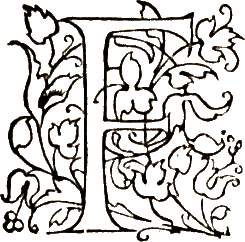 inalmente sopra la piacia ritornato, vidi in questo porphyretico basamento in circuito inscalpto dignissimamente tali hieraglyphi. Primo uno capitale osso cornato di bove, cum dui instrumenti agricultorii, alle corne innodati, et una Ara fundata sopra dui pedi hircini, cum una ardente fiammula, nella facia della quale era uno ochio, et uno vulture. Daposcia uno Malluvio, et uno vaso Gutturnio, sequendo uno glomo di filo, infixo in uno Pyrono, et uno Antiquario vaso cum l’orificio obturato. Una Solea cum uno ochio, cum due fronde intransversate, l’una di oliva et l’altra di palma politamente lorate. Una ancora, et uno ansere. Una Antiquaria lucerna, cum una mano tenente. Uno Temone antico, cum uno ramo di fructigera Olea circunfasciato. Poscia dui Harpaguli. Uno Delphino, et ultimo una Arca reclusa. Erano questi hieraglyphi optima scalptura in questi graphiamenti.
inalmente sopra la piacia ritornato, vidi in questo porphyretico basamento in circuito inscalpto dignissimamente tali hieraglyphi. Primo uno capitale osso cornato di bove, cum dui instrumenti agricultorii, alle corne innodati, et una Ara fundata sopra dui pedi hircini, cum una ardente fiammula, nella facia della quale era uno ochio, et uno vulture. Daposcia uno Malluvio, et uno vaso Gutturnio, sequendo uno glomo di filo, infixo in uno Pyrono, et uno Antiquario vaso cum l’orificio obturato. Una Solea cum uno ochio, cum due fronde intransversate, l’una di oliva et l’altra di palma politamente lorate. Una ancora, et uno ansere. Una Antiquaria lucerna, cum una mano tenente. Uno Temone antico, cum uno ramo di fructigera Olea circunfasciato. Poscia dui Harpaguli. Uno Delphino, et ultimo una Arca reclusa. Erano questi hieraglyphi optima scalptura in questi graphiamenti.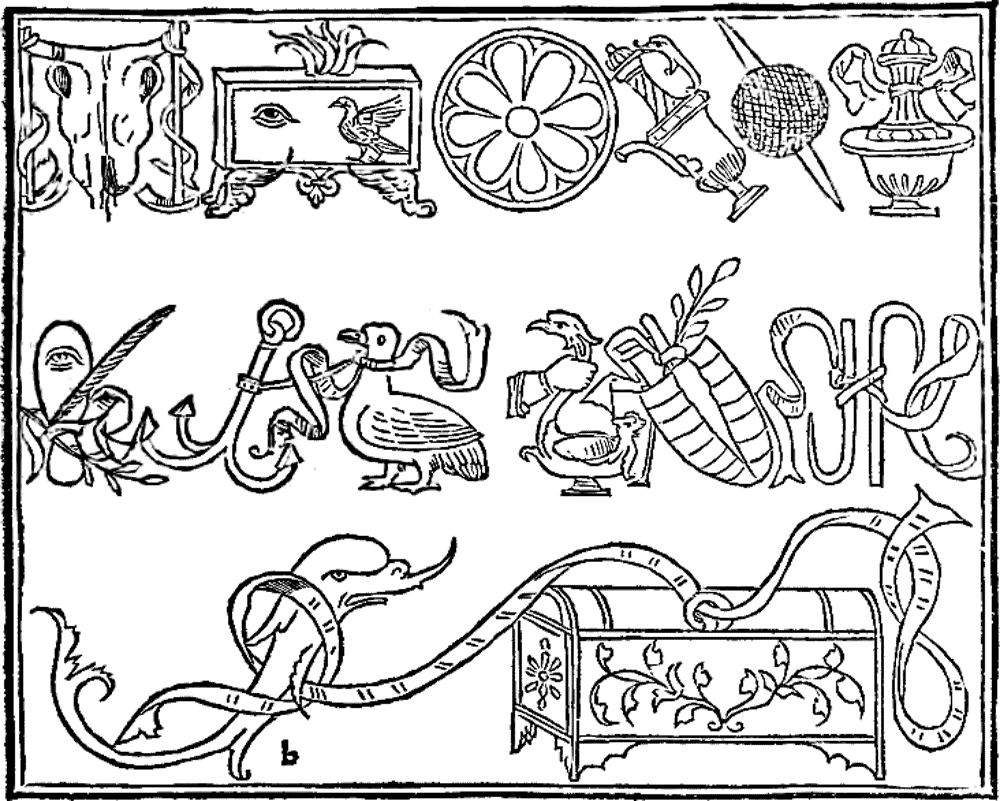
 astly, returned cleane downe, I beheld in the Porphire laste along the sides notably insculpt and grauen these hierogliphies. First, the horned scalpe of an oxe, with two tooles of husbandry fastned to the hornes. An altar standing vpon goates feete, with a burning fire aloft, on the foreside whereof there was also an eie, and a vulture. After that a bason and an ewre. A spindle ful of twind, an old vessel fashioned with the mouth stopped and tied fast. A sole and an eye in the bale thereof and two branches trauersed one of Oliue, an other of Palme tree. An Anchor and a Goose. An olde lampe, and a hand holding of it. An ore of ancient forme with a fruitefull Oliue branch fastned to the handle. Two grapling yrons or hookes. A Dolphin and an Arke close shut. These hierogliphies were passing well cut on this manner. Which ancient maner of writing, as I take it, is thus to be vnderstoode.
astly, returned cleane downe, I beheld in the Porphire laste along the sides notably insculpt and grauen these hierogliphies. First, the horned scalpe of an oxe, with two tooles of husbandry fastned to the hornes. An altar standing vpon goates feete, with a burning fire aloft, on the foreside whereof there was also an eie, and a vulture. After that a bason and an ewre. A spindle ful of twind, an old vessel fashioned with the mouth stopped and tied fast. A sole and an eye in the bale thereof and two branches trauersed one of Oliue, an other of Palme tree. An Anchor and a Goose. An olde lampe, and a hand holding of it. An ore of ancient forme with a fruitefull Oliue branch fastned to the handle. Two grapling yrons or hookes. A Dolphin and an Arke close shut. These hierogliphies were passing well cut on this manner. Which ancient maner of writing, as I take it, is thus to be vnderstoode.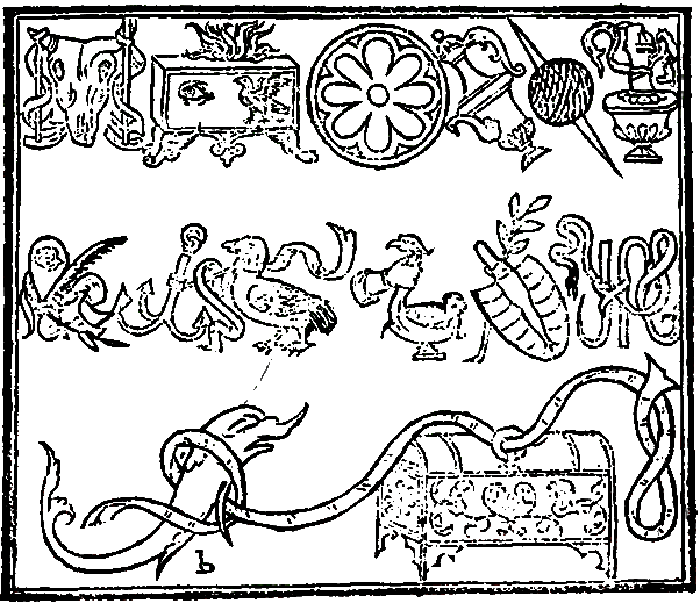
 ber nicht immer tritt so der Charakter spielender Künstlerphantasie hervor, offenbart sich so das rein decorative Bestreben; zumal wenn der Künstler notorisch selbst zum Grübeln neigt und gelehrten Einflüssen leicht zugänglich ist, scheint die Grenzlinie des Annius recht unsicher. Gerade, da er im letzten Grunde für die Auffassung eines Bildwerkes als Hieroglyphe lediglich subjective Kriterien vorbringt, ist es ein glücklicher Zufall, dass zu gleicher Zeit mit Nanni ein ebenso gelehrter wie künstlerisch fein empfindender Humanist sich daran gemacht hatte, eine Mustersammlung hieroglyphischer Inschriften zu entwerfen, die einen Ueberblick über den Betrieb der hieroglyphischen Studien und somit einen weiteren Anhalt zur Beurtheilung gewährt, wo überall die Frührenaissance eine hieroglyphische Absicht vermuthete und entsprechend hieroglyphisch zu schreiben sich bemühte. Ihr Verfasser ist der vielbesprochene, zu Venedig i433 geborene Dominicaner Francesco Colonna und sein Lebenswerk, in das er sie verwob, die berühmte, im December 1499 bei Aldus gedruckte »Hypnerotomachia Poliphili, ubi humana omnia non nisi somnium esse docet«. (...)
ber nicht immer tritt so der Charakter spielender Künstlerphantasie hervor, offenbart sich so das rein decorative Bestreben; zumal wenn der Künstler notorisch selbst zum Grübeln neigt und gelehrten Einflüssen leicht zugänglich ist, scheint die Grenzlinie des Annius recht unsicher. Gerade, da er im letzten Grunde für die Auffassung eines Bildwerkes als Hieroglyphe lediglich subjective Kriterien vorbringt, ist es ein glücklicher Zufall, dass zu gleicher Zeit mit Nanni ein ebenso gelehrter wie künstlerisch fein empfindender Humanist sich daran gemacht hatte, eine Mustersammlung hieroglyphischer Inschriften zu entwerfen, die einen Ueberblick über den Betrieb der hieroglyphischen Studien und somit einen weiteren Anhalt zur Beurtheilung gewährt, wo überall die Frührenaissance eine hieroglyphische Absicht vermuthete und entsprechend hieroglyphisch zu schreiben sich bemühte. Ihr Verfasser ist der vielbesprochene, zu Venedig i433 geborene Dominicaner Francesco Colonna und sein Lebenswerk, in das er sie verwob, die berühmte, im December 1499 bei Aldus gedruckte »Hypnerotomachia Poliphili, ubi humana omnia non nisi somnium esse docet«. (...)
Den sicherlich bei ihm vorhandenen geheimen Wunsch, durch die Kenntnis unbekannter Autoren und Marmorbilder sich hervorzuthun, erreichte er dabei doch. Denn wie er das Bekannte mit dem Erdichteten zusammenstellte, wie er mit einem ungemeinen Citatenreichthum seine Phantasiebilder ausschmückte, wie er seine beachtenswerten archäologischen Kenntnisse zur Beschreibung ersonnener Kunstwerke verwandte, machte er seinen Zeitgenossen den Eindruck, dass die Gespinnste seiner Einbildungskraft ebenfalls auf thatsäcblich Gelesenem und Gesehenem beruhten. Kein geringerer Geist als Erasmus wurde durch die Schilderung seiner Hieroglyphen zu der Vermuthung veranlasst, dass sie den verloren gegangenen Werken des Chaeremon entlehnt seien. Um so weniger braucht man sich zu wundern, dass seine Inschriftensammlung als echt angesehen und wieder abgedruckt worden ist, dass selbst Boissard, der Fälscher, durch ihn getäuscht, das auf ein einfaches Priapusrelief zurückgehende Priapusopfer des Poliphilo als ein antikes Werk in Rom anführt. (...)
Das ist aber nur eine dürftige Andeutung; nicht weniger als drei Obelisken und ein bald Obelisk, bald Pyra genannter Aufbau sind in der Hypnerotomachie ausführlich mit ihren Hieroglyphen beschrieben; ausserdem werden noch weitere hieroglyphische Inschriften gegeben, Citate neben Obelisken aus Diodor, Plinius und Theophrastus, mit Vorliebe wiederholt, Eigenthümlichkeiten des ägyptischen Landes auf Grund Strabons, Herodots und Diodors besonders zum Aufputz von Schilderungen verwendet, sogar die Mysterien des Opfercultes, denen Polia und Poliphil beiwohnen, den ägyptischen Geremonien des Apulejus nachgebildet. Wo es nur dem Autor darauf ankommt, etwas besonders Grossartiges, Uebermenschliches und Mystisches seinem Werke zuzuführen, greift er auf die Nachrichten der Alten über Aegypten zurück, die er eingehend zu diesem Zwecke gesammelt hatte. (...)
Allerdings sind sie ihrem ganzen Wesen nach eine Räthselschrift; aber das war nicht Willkür ihres Erfinders sondern eine Consequenz der änigmatischen Hieroglyphik, wie sie die Alten der Renaissance überlieferten. Colonna kannte zu gut den Ammianus, Diodor und Macrobius, stand in zu enger Fühlung mit der wissenschaftlichen Bewegung seiner Zeit, um nicht in ihrem Sinne diesen neuen Studienzweig auszubilden und zu verwerthen.
Gerade entgegengesetzt der bisherigen Auffassung muss man davon ausgehen, dass jede Hieroglyphe, die er bildete, entweder auf einer classischen Stelle, beziehungsweise einer wirklichen oder dafür gehaltenen ägyptischen Sculptur beruht. Erst beim Fehlschlagen eines solchen Nachweises ist zu vermuthen, dass Colonna seine Phantasie walten liess. (...)
Für die Bildung seiner Sockelhieroglyphen hat Colonna ein umfangreiches literarisches und antiquarisches Material verarbeitet, von dessen Einzelheiten hier wie bei den weiteren Inschriften nur einige Proben besprochen werden, während das Uebrige, so weit als möglich, in den Anmerkungen nachgewiesen ist. Prüft man die von Colonna dabei beobachtete Methode, so muss gegenüber der früheren Auffassung von seiner Hieroglyphik besonders betont werden, dass er sich redlich bemüht hat, wirklich ägyptische Hieroglyphen für seine Räthselschrift zu verwenden. Darüber lassen die beiden hintereinander gestellten Ibisse keinen Zweifel. Er mochte sie auf dem in den sallustischen Gärten, an der Via Appia oder im Circus liegenden Obelisken gesehen haben. Desgleichen bilden Kreisflächen, einzeln oder auch zusammengestellt, häufige Bestandteile der ägyptischen Hieroglyphenschrift. Auch das Auge, die Schlangen und das Schwert gehen auf diese Quelle zurück. Dass sie modern gezeichnet werden, liegt wieder in dem Unvermögen der Renaissance, sich in eine andere Formenwelt hineinzudenken.
Ausser solchen Zeichen, die sich als echt ägyptische Hieroglyphen oder als Münzsymbole nachweisen lassen, enthalten die Räthselbilder des Obeliskensockels allerdings auch offensichtliche Erfindungen Colonnas. Wie die Aegypter bei der Bildung ihrer Determinative vorgingen, zeichnet er einfach den Gegenstand, welchen er schreiben will; so bedeutet z. B. ein Band »vinculum«, ein Tempel »s(acrum)«, die Krone »regnum«, das aus der Scheide gezogene Schwert »evaginata« u. s. w. Auf diesem verführerischen Wege kommt er allerdings zu willkürlichen Bildungen; so geben zwei Senkbleie das Prädicat »erexerunt«, zwei Dreschflegel das Wort »Augustus« wieder. Diese Entfernung von der classischen Symbolik findet aber nur dann statt, wenn er über ein antikes Vorbild für das auszudrückende Wort nicht verfügte.
In den zuletzt erwähnten Fällen war freilich mit der Erfindung des Deutzeichens auch die Deutung vorhanden. Nicht so bequem hat sich Colonna die Wahl der Worte bei den meisten anderen Hieroglyphen gemacht. Das zeigen schon die den Münzen entlehnten Symbole, die er in der Deutung gibt, welche die Beischrift ihm zu enthalten schien, so »pax« beim Caduceus, »divus Julius« beim Kometen, »invicto« bei der Trophäe. Wo eine solche mit mehr oder minder Recht auf das Symbol bezogene Inschrift der Münzen dem Colonna nicht zu Gebote stand, beruht oft die wörtliche Bedeutung des herangezogenen Bildes auf einer ausserordentlich spitzfindigen und erklügelten Ueberlegung, die sich wieder auf classische Stellen gründet. Offenbar brachte ihn die bekannte Stelle des Herodot über die Kosten der Pyramidenbauten auf den Gedanken, in den Kreisflächen Münzstücke zu sehen, und liessen die Nachrichten von den Vorkommen des Ibis in Aegypten diesen Vogel als das Wappen des Landes betrachten. Als ein besonderes Beispiel wissenschaftlichen Grübelns sei hier noch die Hieroglyphe des cyclo für »semper« angeführt, über welche Erasmus später einen besonderen Commentar schrieb. Auch bei Colonnas Belesenheit wird man annehmen können, dass er diese Deutung des Kreises aus Virgil, Servius und Diodor herausdestillirte; vielleicht hat er auch von der zu einem Kreise gerollten Schlange als Sinnbild des »aevum« gehört, von der Horapollon berichtet. Jedenfalls besteht das Bestreben, die alten Zeichen aus antiken Vorstellungen zu erklären. Wenn dabei auch Aegyptisch, Griechisch und Römisch zusammengeworfen wird, so offenbaren sich doch die Anfänge eines gewissen Abstractionsvermögens. Entsprechend beruhen nur einige Erklärungen auf mittelalterlichen Vorstellungen; so der Hund für »amicitia«, die Schlange für »odium« oder »prudentia«. (...)
Um die nur einem logischen Denken sich enthüllende Weisheit dieser Hieroglyphenreihe gebührend zu kennzeichnen, lässt Colonna den Poliphilo zunächst vor der Bedeutung der den Schädel umgebenden Zweige rathlos stehen und erst nach so und so viel Seiten mit Hilfe der ihm inzwischen zugesellten Nymphe Logistica, der Personification der Vernunft, das Räthsel lösen. (...)
Thatsächlich finden sich also in der Hypnerotomachie, abgesehen von dem Worte »emblematura« auch sonst die wesentlichen Gedanken, welche den später »Emblemata« genannten Sammlungen von Mustersinnbildern für Künstler zu Grunde liegen. Es fehlt nur die poetische Form der Anempfehlung; sowie jemand auf den naheliegenden Einfall kam, solche hieroglyphische Zeichen, zu sinnreichen Gedanken zusammengestellt, in knappen Versen zu beschreiben, hatte sich die Emblematik, wie sie die bildenden und dichtenden Künste für Jahrhunderte beschäftigen sollte, vollkommen ausgebildet.
— Karl Giehlow: Die Hieroglyphenkunde des Humanismus in der Allegorie der Renaissance. In: Kunsthistorisches Museum WienJahrbuch der Kunsthistorischen Sammlungen in Wien. Wien: Halm & Goldmann, 1883. pp. 46-48, 55-58, 79.
 oliphilo’s dream world is dominated by a conflated version of antiquity with structures that combine architectural traditions from different periods and cultures (Egyptian, Greek, Roman, Early Christian); with a language that mixes ancient Greek and Latin with the Italian vernacular and allusions to or inscriptions in other ancient languages (Etruscan, Chaldaic, Hebrew, Arabic, and of course Egyptian hieroglyphs); and with imagery and rituals that reference a multitude of myths and stories from the classical and the medieval tradition. Hieroglyphs, in particular, have a prominent place in the dream. To understand their role and narrative function, it is necessary to examine where, in what form, and why hieroglyphs appear or are mentioned in the narrative.
oliphilo’s dream world is dominated by a conflated version of antiquity with structures that combine architectural traditions from different periods and cultures (Egyptian, Greek, Roman, Early Christian); with a language that mixes ancient Greek and Latin with the Italian vernacular and allusions to or inscriptions in other ancient languages (Etruscan, Chaldaic, Hebrew, Arabic, and of course Egyptian hieroglyphs); and with imagery and rituals that reference a multitude of myths and stories from the classical and the medieval tradition. Hieroglyphs, in particular, have a prominent place in the dream. To understand their role and narrative function, it is necessary to examine where, in what form, and why hieroglyphs appear or are mentioned in the narrative.
To start with, the first mention of hieroglyphs is to be found already in the paratextual elements of the book, in the prose synopsis addressed to the reader, where reference is made to the enigmatic three-sided obelisk: in medio era expressa la trinitate in figure hieroglyphe, cioe sacre scalpture aegyptie (“in the middle was represented the Trinity in hieroglyphic figures, that is, sacred Egyptian inscriptions”). (...)
All instances where Poliphilo encounters or mentions hieroglyphic inscriptions are to be found in Book I of the Hypnerotomachia, where they are linked either with a ruined landscape or with a locus of transition: at the ruined city (a8v (mention), b7r (mention), b7v, c1r); in the realm of Queen Eleuterylida (d7r, e1v-e2r (mention), h5r, h6v, h7r, h7v); at the Polyandrion (p6r, p6v, p7r-v, q7r (mention), q7v); at the sea voyage to the Cytherean island (s1r (mention), s2v (mention), s3v). In each case, Poliphilo and, in one instance, his interlocutor (Logistica) identify these inscriptions as hieroglyphi or hieraglyphi aegyptici insculpti regardless of their form, making thus clear reference to their linkage with what was considered as the holy writings of the ancient Egyptians. Regarding form, there are two types of hieroglyphic inscriptions in the book: those with symbols resembling Egyptian hieroglyphs and the so-called “Renaissance hieroglyphs”, a term used to refer to symbolic signs created during the Renaissance inspired by the idea of Egyptian hieroglyphs to conceal meaning in an image. In the Hypnerotomachia, both types are characterized as Egyptian hieroglyphs and form part of the same language; a made-up, or rather oneiric, visual language that accentuates the simultaneous alterity and familiarity of the dream world and that can also provide access to the divine through the decipherment of each inscription. The absence of hieroglyphs from Book II of the Hypnerotomachia is not surprising, as Polia’s story contained therein takes place in a pseudo-historical Treviso and not in the dream world of Poliphilo. The verisimilitude of Treviso creates an intentional, in my opinion, confusion as to whether Polia’s story is an actual memory from Poliphilo’s waking life or whether it is a product of the dream, an imagined past, a wish-fulfillment. (...)
In conclusion, hieroglyphic inscriptions seem to be strategically placed by the author of the Hypnerotomachia at certain moments in the dream narrative of Book I with specific functions. Firstly, they provoke both the dreamer’s and the reader’s curiosity and instigate processes of interpretation that lead to key messages for the development of the narrative and for the spiritual and psychological development of the dreamer, while also providing useful lessons to the reader in the form of adages, such as “always hasten slowly”. The method of interpretation of the various spatial objects combining symbolic images and their inscriptions to unlock their hidden meanings as well as Poliphilo’s contemplative experience through this interpretative process is not only indicative of how a reader should approach this particular work, but also resembles a reader’s interaction with emblem books, to which the Hypnerotomachia Poliphili is generally considered a precursor. Secondly, hieroglyphs signal or even facilitate the dreamer’s initiation process by providing guidance as to his next steps and by being placed at transitional moments in the narrative, e.g. on the two bridges framing the realm of Queen Eleuterylida and on Cupid’s boat. Even the hieroglyphs on funerary monuments in the ruined city and the Polyandrion could be considered as transitional marking the passage from life to death. Thirdly, they have a mnemotechnic function both in their narrative function as visual reminders to Poliphilo, aiding him in his journey and in their form as monumental inscriptions. The word monumento (from Latin monere, ‘to remind’) — used in the book in both its meanings as monuments and reminder — is inherently linked to memory and, of course, monuments do have a commemorative function, preserving the memory of the past. Finally, the presence of hieroglyphs in Book I of the Hypnerotomachia adds to the alienating effect of the liminal spaces of the dream, contributing to the construction of an invented, hybrid Antiquity that deeply fascinates and bewilders both Poliphilo and the readers.
— Efthymia Priki: The Narrative Function of Hieroglyphs in the Hypnerotomachia Poliphili. January 2020.
 t follows that all mystical images, because they retain a certain articulation by which they are distinguished as ‘hedges’ or umbraculae, belong to an intermediate state, which invites further ‘complication’ above, and further ‘explication’ below. They are never final in the sense of a literal statement, which would fix the mind to a given point; nor are they final in the sense of the mystical Absolute in which all images would vanish. Rather they keep the mind in continued suspense by presenting the paradox of an ‘inherent transcendence’; they persistently hint at more than they say. It is a mistake, therefore, to overlook a certain ambiguity in the praise of hieroglyphs which Ficino, and after him Giordano Bruno, adopted from an incidental remark by Plotinus. In a famous passage of the fifth Enead, Plotinus had suggested that Egyptian ciphers are more suitable for sacred script than alphabetic writing because they represent the diverse parts of a discourse as implicit, and thus concealed, in one single form. Since Pico ascribed the same virtue to the writing of Hebrew without vowels, it is legitimate to suspect that the Renaissance speculations on ‘implicit signs’ were not concerned with a positive theory of optical intuition, but with that far less attractive subject called steganography, the cryptic recording of sacred knowledge. Because God, in the opinion of Ficino, ‘has the knowledge of things not by a multiplicity of thoughts about an object, but by a simple and firm grasp of its essence’, it seemed only right that the Egyptian priests had imitated the divine comprehension in their script, signifying ‘the divine mysteries not by the use of minutely written letters, but of whole figures of plants, trees, and beasts’. But as Erasmus observed in the Adagia, the content of these figures was not meant to be open to direct inspection, or ‘accessible to anyone’s guess’ (ut non cuius statim promptum esset conjicere); they presupposed in the reader a full acquaintance with the properties of each animal, plant or thing represented: ‘is demum collatis eorum symbolorum coniecturis aenigma sententiae deprehendebat.’ Thus, contrary to the divine intelligence which the reading of hieroglyphs is supposed to foreshadow, the intuitive grasp of them depends on discursive knowledge. Unless one knows what a hieroglyph means, one cannot see what it says. But once one has acquired the relevant knowledge, ‘unfolded’ by more or less exoteric instruction, one can take pleasure in finding it ‘infolded’ in an esoteric image or sign.
t follows that all mystical images, because they retain a certain articulation by which they are distinguished as ‘hedges’ or umbraculae, belong to an intermediate state, which invites further ‘complication’ above, and further ‘explication’ below. They are never final in the sense of a literal statement, which would fix the mind to a given point; nor are they final in the sense of the mystical Absolute in which all images would vanish. Rather they keep the mind in continued suspense by presenting the paradox of an ‘inherent transcendence’; they persistently hint at more than they say. It is a mistake, therefore, to overlook a certain ambiguity in the praise of hieroglyphs which Ficino, and after him Giordano Bruno, adopted from an incidental remark by Plotinus. In a famous passage of the fifth Enead, Plotinus had suggested that Egyptian ciphers are more suitable for sacred script than alphabetic writing because they represent the diverse parts of a discourse as implicit, and thus concealed, in one single form. Since Pico ascribed the same virtue to the writing of Hebrew without vowels, it is legitimate to suspect that the Renaissance speculations on ‘implicit signs’ were not concerned with a positive theory of optical intuition, but with that far less attractive subject called steganography, the cryptic recording of sacred knowledge. Because God, in the opinion of Ficino, ‘has the knowledge of things not by a multiplicity of thoughts about an object, but by a simple and firm grasp of its essence’, it seemed only right that the Egyptian priests had imitated the divine comprehension in their script, signifying ‘the divine mysteries not by the use of minutely written letters, but of whole figures of plants, trees, and beasts’. But as Erasmus observed in the Adagia, the content of these figures was not meant to be open to direct inspection, or ‘accessible to anyone’s guess’ (ut non cuius statim promptum esset conjicere); they presupposed in the reader a full acquaintance with the properties of each animal, plant or thing represented: ‘is demum collatis eorum symbolorum coniecturis aenigma sententiae deprehendebat.’ Thus, contrary to the divine intelligence which the reading of hieroglyphs is supposed to foreshadow, the intuitive grasp of them depends on discursive knowledge. Unless one knows what a hieroglyph means, one cannot see what it says. But once one has acquired the relevant knowledge, ‘unfolded’ by more or less exoteric instruction, one can take pleasure in finding it ‘infolded’ in an esoteric image or sign.
Thus the rules of ‘explication’ and ‘complication’, by which we found the Orphic images to be governed, apply to Renaissance hieroglyphs as well. They are, all of them, ‘hedges’ or umbraculae, infested with the paradox of self-transcendence. For it is a general rule of Neoplatonic symbolism, because Pan is always inherent in Proteus, that any figure tends to engender others, they abhor isolation. This explains why the mystical language grows so easily luxuriant, and produces the kind of cumulative verbiage which disfigures many Neoplatonic tracts, and is often carried over into visual imagery. The Neoplatonic discipline tried to restrain and direct the unruly impulse without depriving it of its poetry. The contraction and expansion of metaphors were subjected to a few simple dialectical rules which were to secure a rich but reasonable ‘genealogy of the gods’, a succession of steps which, broadening downward and narrowing towards the top, promised ecstasy while advising prudence.
‘Now the Supreme, because within it are no differences,’ says Plotinus in the sixth Ennead, ‘is eternally present; but we achieve such presence only when our differences are lost. ... We have at all times our centre There, though we do not at all times look Thither. We are like a company of singing dancers, who may turn their gaze outward and away, notwithstanding they have the choirmaster for centre; but when they are turned towards him, then they sing true and are truly centred upon him. Even so we encircle the Supreme always, and when we break the circle, it shall be our utter dissolution and cessation of being; but our eyes are not at all times fixed upon the Centre. Yet in the vision thereof is our attainment and our repose and the end of all discord, God in his dancers and God the true Centre of the dance.’ [VI,ix,8; tr. Dodds]
— Edgar Wind: Pagan Mysteries in the Renaissance. New and enlarged edition. London: Faber and Faber, 1968. pp. 106-109.
Magie & Mnemonik
 erhaps an artificial memory gone out of control into wild imaginative indulgence might be one of the stimuli behind such a work as the Hypnerotomachia Polyphili, written by a Dominican before 1500, 48 in which we meet, not only with Petrarchan triumphs and curious archaeology, but also with Hell, divided into places to suit the sins and their punishments, with explanatory inscriptions on them. This suggestion of artificial memory as a part of Prudence makes one wonder whether the mysterious inscriptions so characteristic of this work may owe something to the influence of visual alphabets and memory images, whether, that is to say, the dream archaeology of a humanist mingles with dream memory systems to form the strange fantasia.
erhaps an artificial memory gone out of control into wild imaginative indulgence might be one of the stimuli behind such a work as the Hypnerotomachia Polyphili, written by a Dominican before 1500, 48 in which we meet, not only with Petrarchan triumphs and curious archaeology, but also with Hell, divided into places to suit the sins and their punishments, with explanatory inscriptions on them. This suggestion of artificial memory as a part of Prudence makes one wonder whether the mysterious inscriptions so characteristic of this work may owe something to the influence of visual alphabets and memory images, whether, that is to say, the dream archaeology of a humanist mingles with dream memory systems to form the strange fantasia.
— Frances Yates: The Art of Memory. London: Routledge & Kegan Paul,1966. pp. 123-124.
 here is a strong vein of magic running throughout Poliphilo’s dream. Despite the usual assumption that Ficinian magic was a parallel development entirely distinct from the magical atmosphere of the Hypnerotomachia, there are certainly Hermetic and thaumaturgical elements in the latter. The magic of animated statues especially, so notoriously associated with the Hermetic Asclepius, is in abundant supply in the Hypnerotomachia.[121] Furthermore, the exotic rituals of the story are suggestive of magic. Such an indication is particularly evident in the ceremony at the temple of Venus Physizoa, with its “many arcane words and conjurations,” the overtones of theurgy in the bird sacrifices, and the tracing of cryptic sigils in blood.[122]
here is a strong vein of magic running throughout Poliphilo’s dream. Despite the usual assumption that Ficinian magic was a parallel development entirely distinct from the magical atmosphere of the Hypnerotomachia, there are certainly Hermetic and thaumaturgical elements in the latter. The magic of animated statues especially, so notoriously associated with the Hermetic Asclepius, is in abundant supply in the Hypnerotomachia.[121] Furthermore, the exotic rituals of the story are suggestive of magic. Such an indication is particularly evident in the ceremony at the temple of Venus Physizoa, with its “many arcane words and conjurations,” the overtones of theurgy in the bird sacrifices, and the tracing of cryptic sigils in blood.[122]
Memory arts were associated with magic in the medieval period, during which the pseudo-Solomonic ars notoria fused the desire for mnemonic puissance (as expressed through knowledge and rhetorical ability) with sorcerous omniscience and the ceremonial evocation of spirits. The memory systems of Albertus and Aquinas were intended to displace this dangerous and disreputable art with an ars memorativa based in the civility of Cicero and the respectability of Aristotle. But memory could not stay free of magic. The involvement of memory in the creative and comprehensive faculties was indicated by the proximity of memoria to inventio in the rhetorical lexicon, where the latter was both compositional “invention” and mnemonic “inventory.”
During the early modern Renaissance, the association of magic with artificial memory only grew stronger. In 1532, Giulio Camillo appealed to the authority of Avicenna in correlating the magical powers of imaginatio to the potentials of his memory theater. Della Porta’s Magia naturale (1558) included
During the early modern Renaissance, the association of magic with artificial memory only grew stronger. In 1532, Giulio Camillo appealed to the authority of Avicenna in correlating the magical powers of imaginatio to the potentials of his memory theater. Della Porta’s Magia naturale (1558) included advice regarding artificial memory and warnings against the use of drugs for mnemonic purposes. Ioan P. Couliano has declaratively summed up the larger intersection of these concerns: “The bond between eroticism, mnemonics, and magic is indissoluble to such an extent that it is impossible to understand the third without first having studied the principles and mechanisms of the first two.” And all three are patently present in the Hypnerotomachia.
One connection between eroticism and mnemonics is anatomical in nature. Both are concerned with the heart. A tradition descending from Aristotle and the Stoics through medieval Scholasticism clearly marks out the heart as the center of both vitality and intelligibility. Even after anatomical opinion tended to relocate all mental faculties in the brain, memory continued to be identified with the heart, as it still is in the English idiom: “to learn (or know) by heart.” Early etymologies of the Latin verb recordari and its Italian progeny recordarsi relate these words for recollection to cor “heart.”129 Lina Bolzoni discusses the later importance of “The Window Opening onto the Heart” in the literature of the Italian Renaissance, and she also specifies its architectural provenance—from the third book of Vitruvius’ De architectura. So Poliphilo’s heart is metaphorically a building, like all those larger structures that he describes from his dream. (Yet they are all within his memory and therefore inside his “heart”!) On the one hand, Poliphilo’s urgent and repeated attention to his “hesitating,” “disquieted,” “agitated,” “sad,” “burning and hungry” heart expresses his desire for Polia.[131] But to the reader who can keep in mind the largest, waking frame of the story, it also signifies his overheated memory of her. Couliano reviews a wide variety of sources in order to propose an anatomical assignment of magic to the heart. Since Renaissance magic (in sensu Couliano) depends on the production of phantasms, it seems as if magic and memory might have a common dependence on the heart’s capacity for phantasy.
Besides the magia of Poliphilo’s erotic dream, there is also a sense in which the machia functions as machina. Isidore of Seville’s Etymologiae — still popular in the fifteenth century and a likely reference for Colonna in light of the latter’s philological interests — defines machina as a device employed by masons for building construction, a shift in meaning that makes it in some respects more general, and in others more specific, than its classical sense as a hoist. In the passage of the Hypnerotomachia regarding the giant pyramid-obelisk portal, Poliphilo wonders about the method of its construction. He refers to “capstans and pulley blocks, […] cranes, compound pulleys, frameworks of beams and other lifting machines” that must have been used in erecting it.[135] According to Lefaivre, the polispasio is a sort of crane supported by ropes and a single pole, and the capre uses a rigid tripod to achieve the same hoisting results.
The “artificial” or trained memory itself can be understood as the machina used to construct the architectural “places” (loci) used in mnemonic arts, and this understanding is linked to the idea of education as the building of character, two concepts united through the idea of aedificatio: edification and the manufacture of an edifice. (...)
This fascination with artifice and automation is reflected in the Hypnerotomachia on various occasions. For example, when Poliphilo visits the octagonal bath building with the nymphs of the five senses, he witnesses that it is crowned with a device that combines a weather vane and a horn, so that it automatically turns itself to use the force of the wind to produce its tone.[144] In the bath itself, he treads on a movable stone step that triggers a fountain (in the form of a pissing child) to redirect its spray to his face. After recovering his composure, Poliphilo remarks, “I found this machine and its curious device most gratifying.”[145] At the end of the banquet of Queen Eleuterylida, a nymph brings around an elaborate fountain on a cart, where the turning of the wheels pumps the fountain, and causes it to spray perfumed water on all of those whom it passes.[146] And the temple of Venus Physizoa has great gilded doors that open themselves when unbolted, by the action of powerful lodestones acting on steel plates built into the doors.[147]
So the numinous ambivalence of the title Hypnerotomachia calls forth both Hypnerotomagia and Hypnerotomachina: two shadows in the light of mnemonic paronomasia, elaborating the images of Poliphilo’s dream.
— Matthew D. Rogers: A Renaissance Seduction of Memory: Colonna’s Hypnerotomachia as Counter-edification. Universiteit van Amsterdam, 2004. pp. 31-36.
Titelaufnahmen aus Katalog 7:
GIOVANNI POZZI | FRANCESCO COLONNA UND | ALDO MANUZIO | Bild aus der Hypnerotomachia | SETZMASCHINEN-FABRIK MONOTYPE GESELLSCHAFT m. b. H. | FRANKFURT AM MAIN UND BERLIN-NEUKÖLLN | MCMLXII.
Frankfurt/Berlin: Monotype, 1962.
Octavo. 230 × 153 mm. [1] w.Bl., [1] Bl., Ss. 5-35, [1] Bl., [1] w.Bl.
Rot und schwarz bedruckter Original-Umschlag aus grau-braunem Maschinenbüttenkarton.
Diese Veröffentlichung ging der kritischen Ausgabe der Hypnerotomachia Poliphili voraus und erschien gleichzeitig in deutscher, französischer und italienischer Sprache, wobei die deutsche Übersetzung von Ricarda Liver rührt. Gedruckt in der Monotype Polophilus-Antiqua und der Blado-Kursive auf Maschinenbütten.
THE | STRIFE OF LOUE IN A DREAM | BEING | THE ELIZABETHAN VERSION | OF THE FIRST BOOK OF THE | HYPNEROTOMACHIA | OF | FRANCESCO COLONNA | A NEW EDITION | BY | ANDREW LANG, M.A. | Signet | LONDON | PUBLISHED BY DAVID NUTT IN THE STRAND | MCCCCXC.
Kolophon S. (249): Signet, dann: CHISWICK PRESS:-C. WHITTINGHAM AND CO., | TOOKS COURT, CHANCERY LANE.
London: Nutt, 1890.
Quarto. ca. 264 × 175 mm. [2] Bll., Ss. v-xvii; [4] Bll., 248 Ss.; [1] Bl.
Original-Pappband mit Rückentitel und Titel auf dem Vorderdeckel in Mattgoldprägung.
Neudruck der einzigen englischen Übertragung aus dem Jahre 1592, die nur den ersten Teil der Hypnerotomachia umfaßte, hier jedoch um die Holzschnitten der italienischen Originalausgabe vermehrt; anderes ist in englischer Übersetzung bis 1999 nicht erschienen. - Von der Chiswick Press auf Bütten mit ihrem Wasserzeichen gedruckt. Auf dem Verso des Vortitels: “Five hundred copies of this Edition are printed”.
HYPNEROTOMACHIE, | OV || Discours du songe | DE POLIPHILE, | Déduisant comme Amour le combat | à l’occasion de Polia. | Traduit de langage italien en français | par Jean Martin et Jacques | Gohorry, et decoré de des-|sins de Mantegna | Graves sur bois par Jean Cousin et | Jean Goujon. | PUBLIE par Bertrand Guégan, d’après | l’édition Kerver. [1546] || PAYOT, PARIS.
Kolophon S. (321): Justification du Tirage | CE VOLUME A ETE ACHEVE D’IMPRIMER LE | mardi XXII juin MCMXXVI, sur les presses des Artisans | Imprimeurs. L’impression a été dirigée par Fernand Lefèvre, | l’exécution des gravures par Serge Czerefkow. Le tirage est limité | à mille trois cent trente-cinq exemplaires dont trente cinq sur papier impérial | du Japon chiffrés de I à XXXV et mille trois cents sur papier | Hollande vergé de Rives chiffrés de 1 à 1300. Il a été tiré en outre | vingt-cinq exemplaires hors commerce numérotés de A à Z. || Le present exemplaire est chiffré: | 1172.
Paris: Payot, 1926.
Quarto. 232 × 180 mm. [1] w.Bl., [3] Bll.; 311 Ss.; [5] Bll., [1] w.Bl.
Dunkelblaues Halbmaroquin auf acht echten Bünden und Holzdeckeln. Handgestochene Kapitale in hellbrauner Seide, Schnitt hellbraun gesprenkelt.
Eins von 1300 Exemplaren auf Rives-Bütten, Gesamtauflage 1360. Der Text der Hypnerotomachia liegt hier komplett auf Französisch vor.
HYPNEROTOMACHIA | POLIPHILI | Venice 1499 || Francesco Colonna || Garland Publishing, Inc., New York & London | (Signet) | 1976.
New York: Garland, 1976.
Quarto. 254 × 177 mm. [3] Bll.; [234] Bll. (Faksimile).
Originalleinwand mit Silberprägung auf dem Rücken.
Der etwas verkleinerte Nachdruck folgt dem Exemplar der Bodleian Bibliothek. Erster Band der Reihe “The Renaissance and the Gods”.
The Strife of Love in a Dreame
